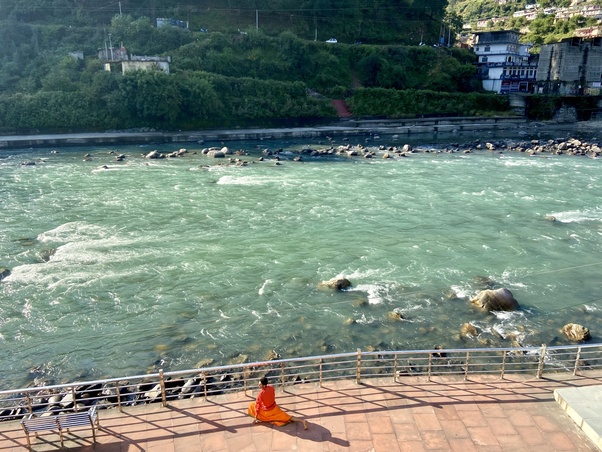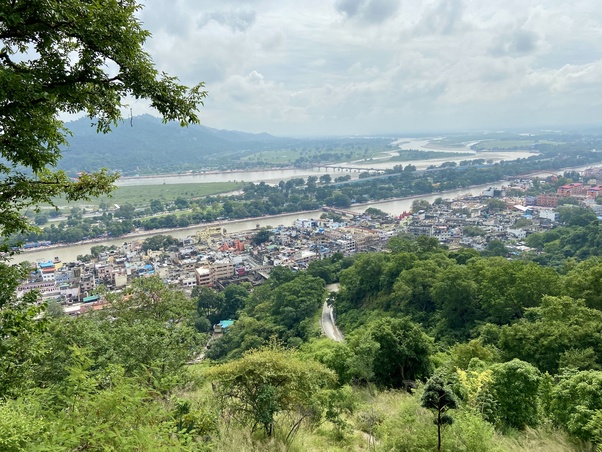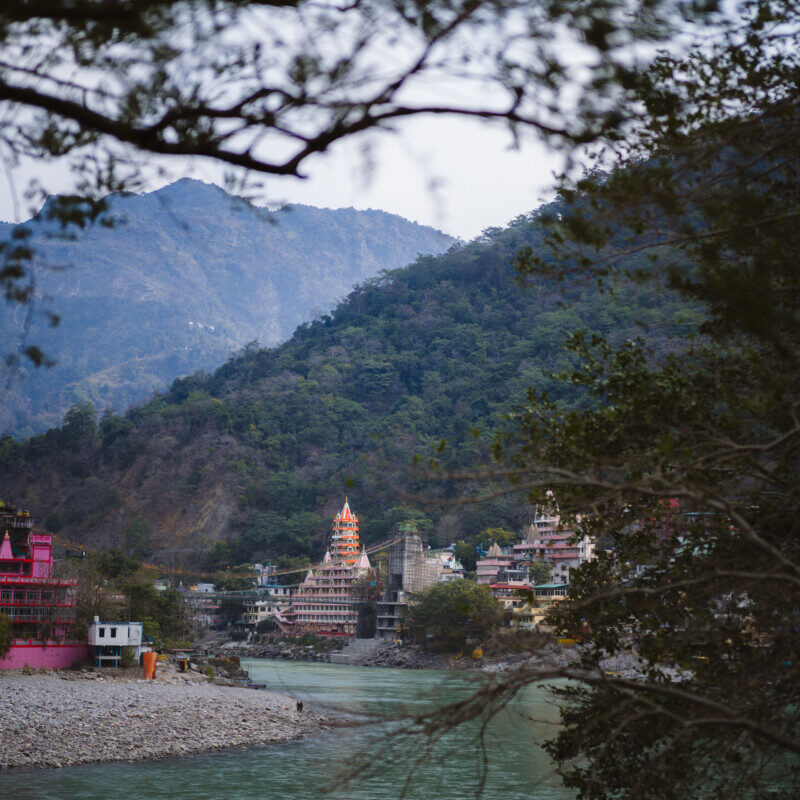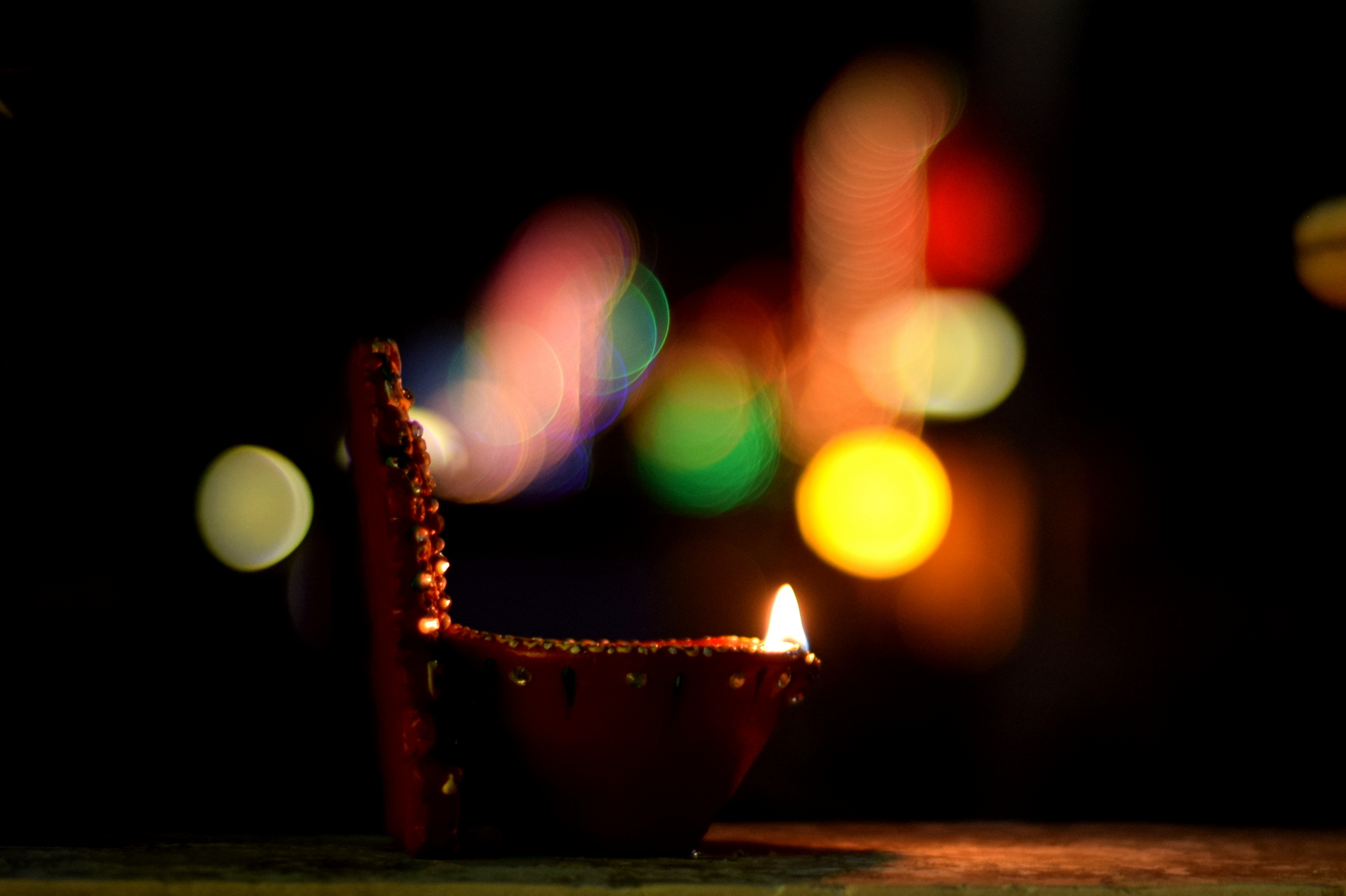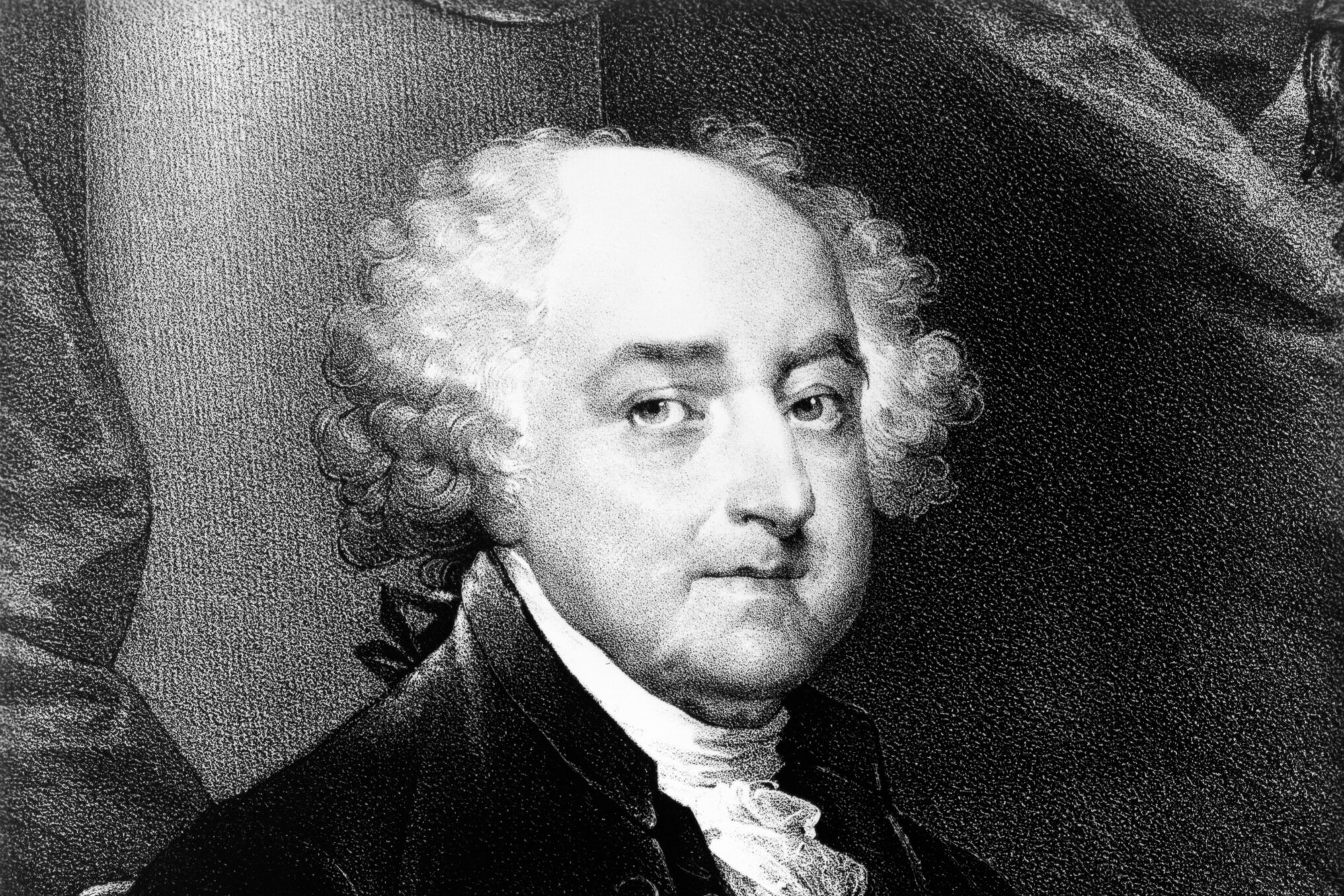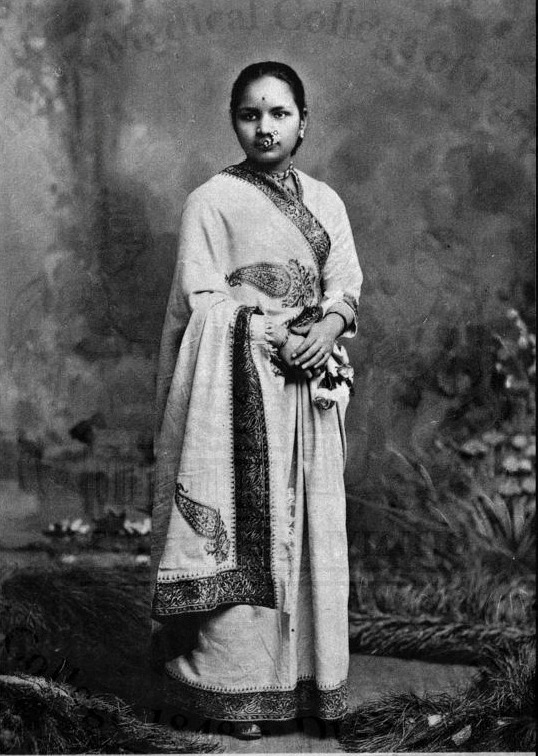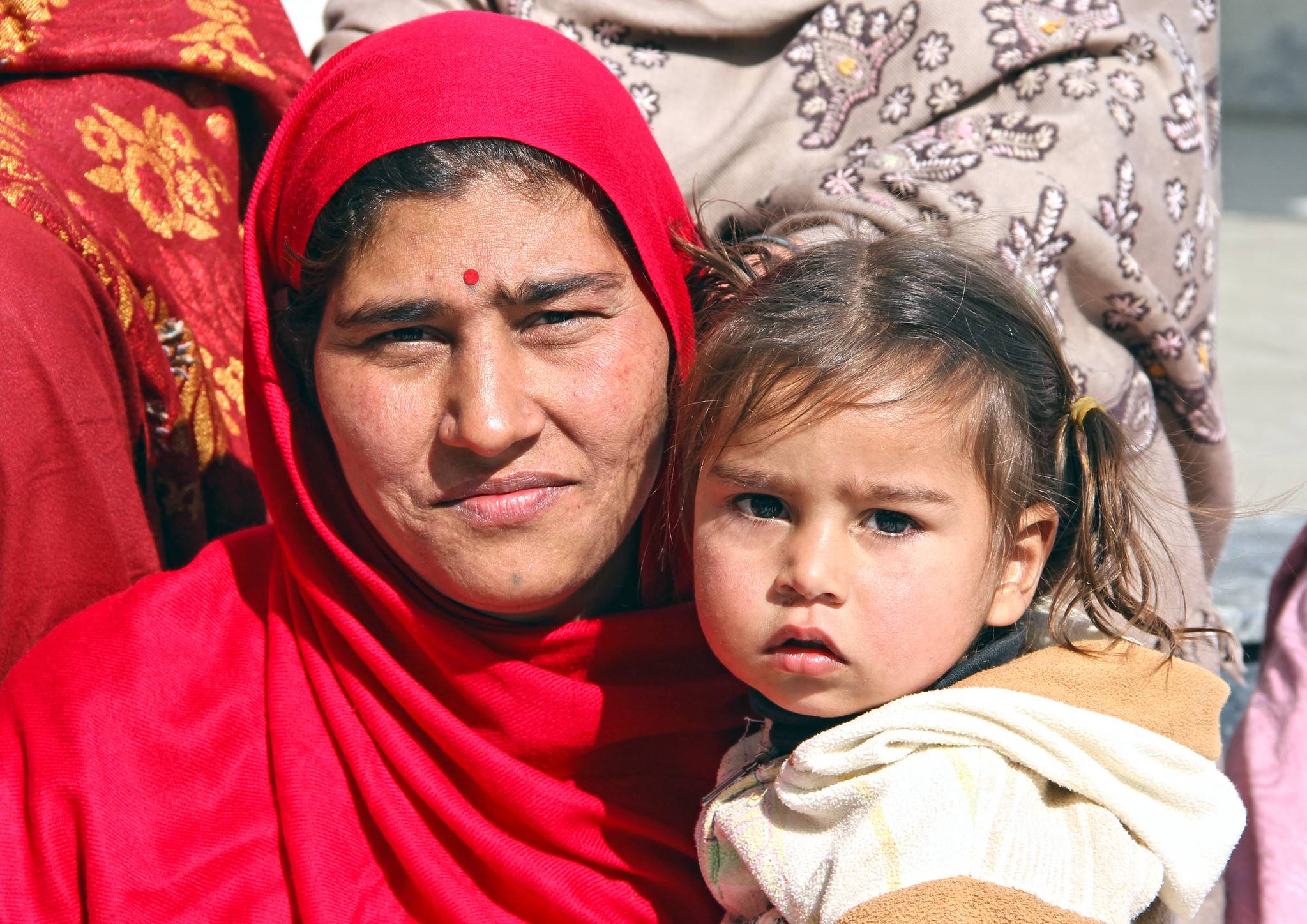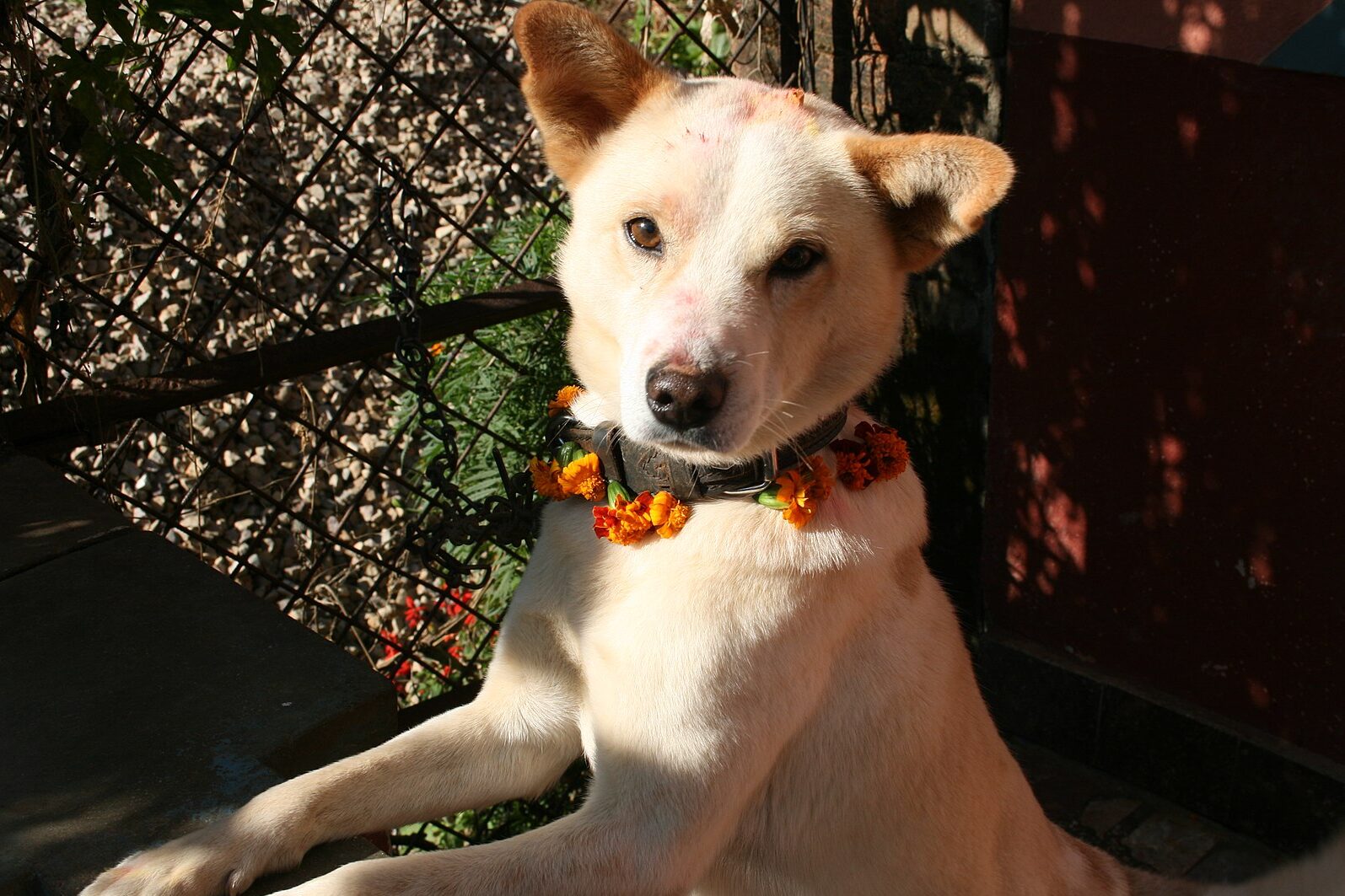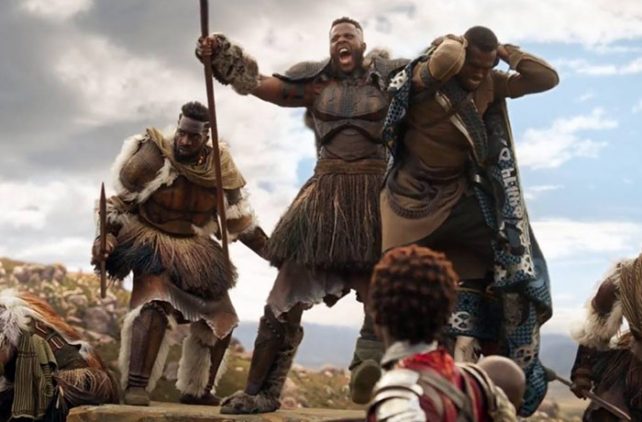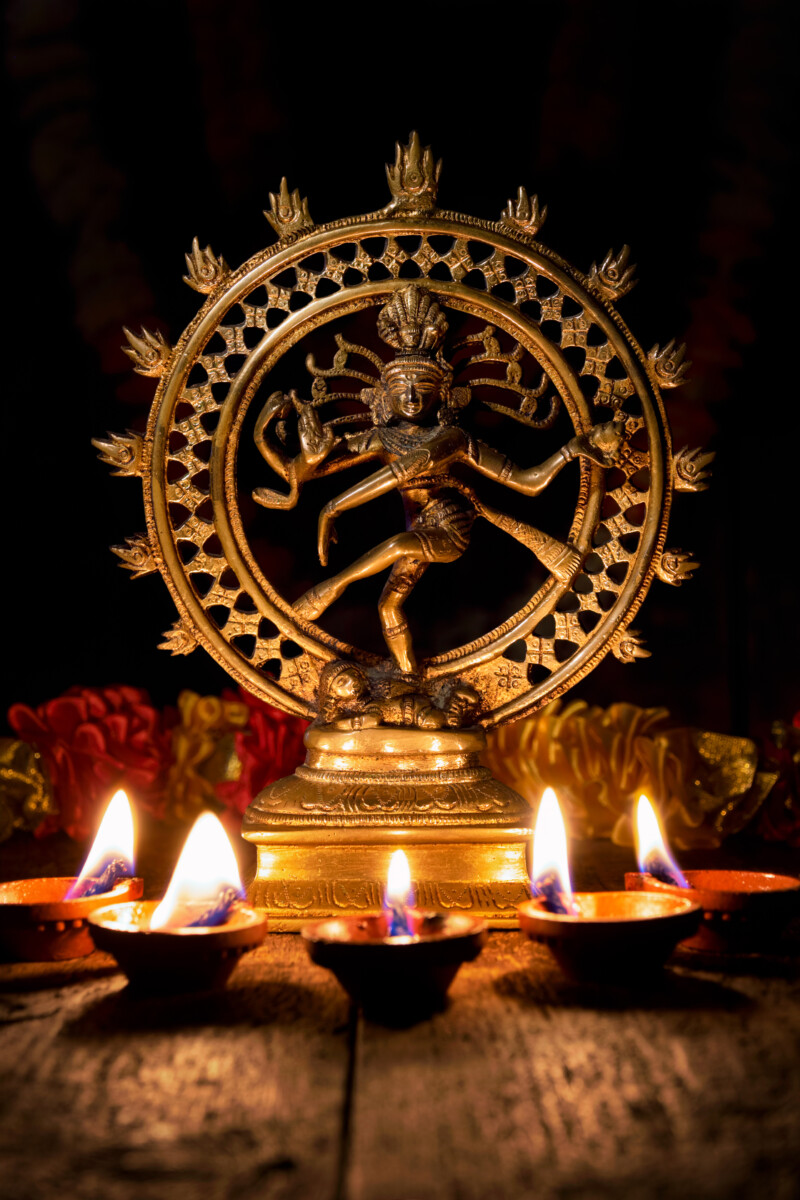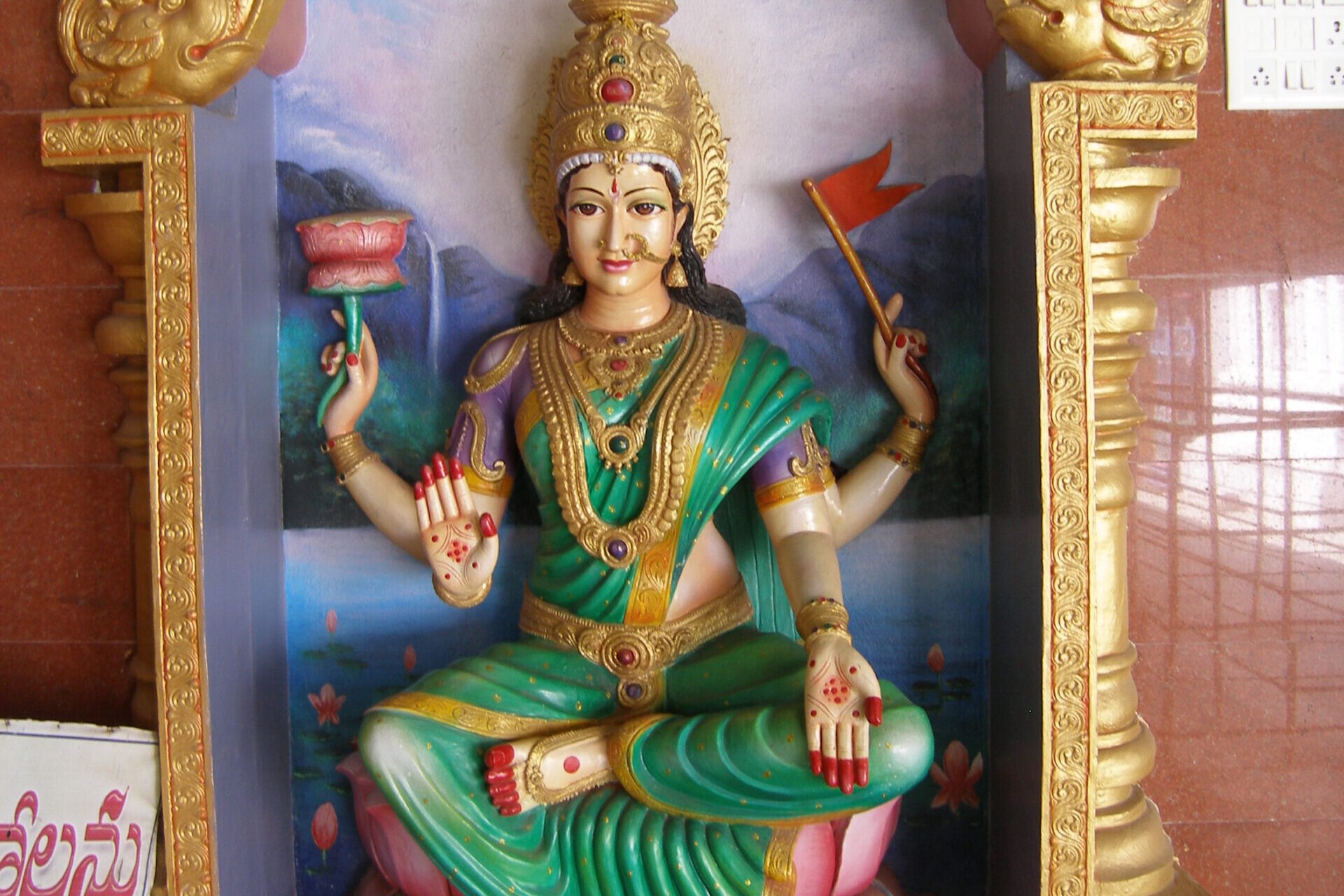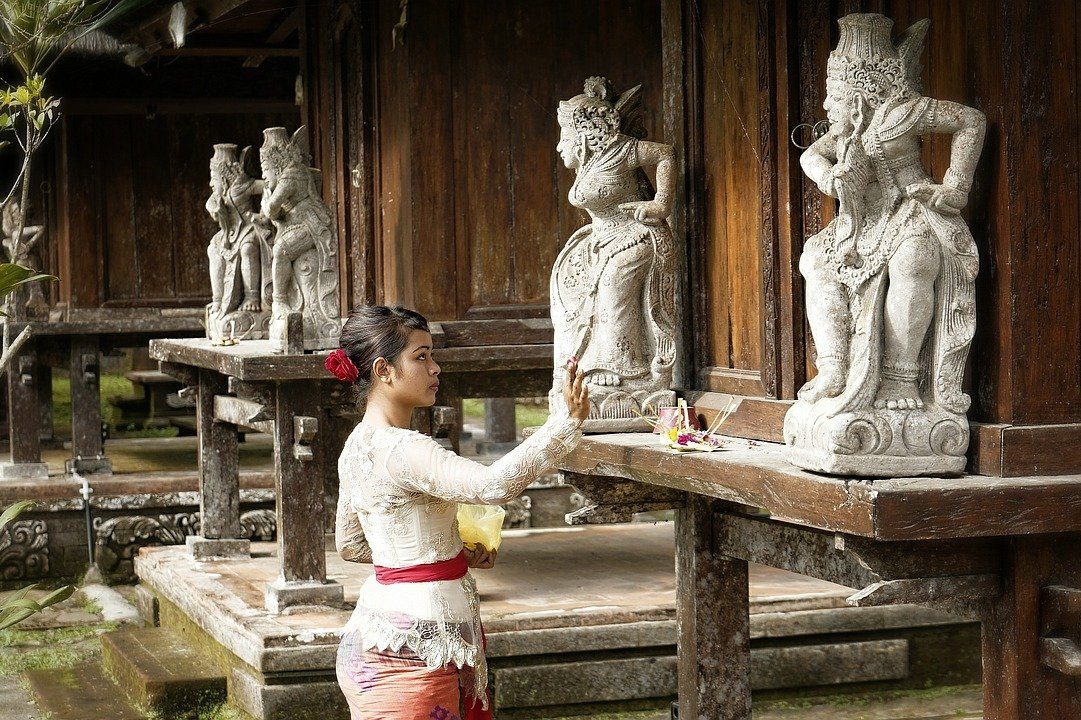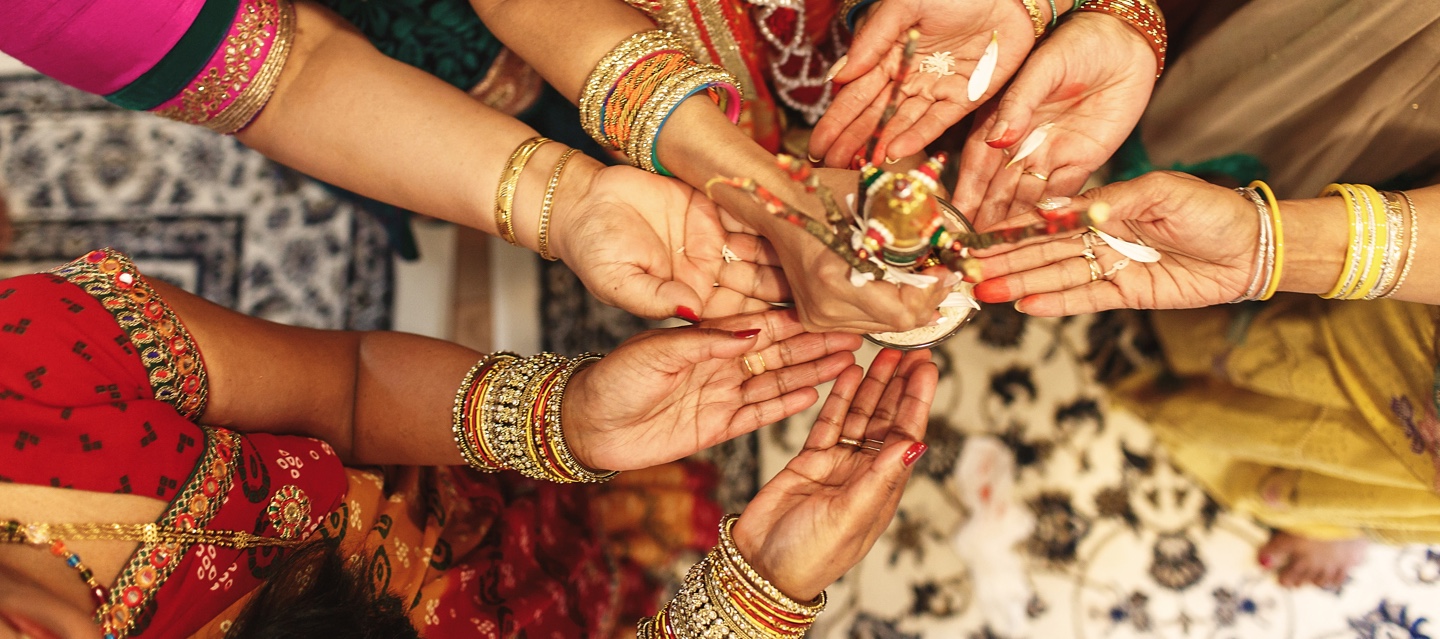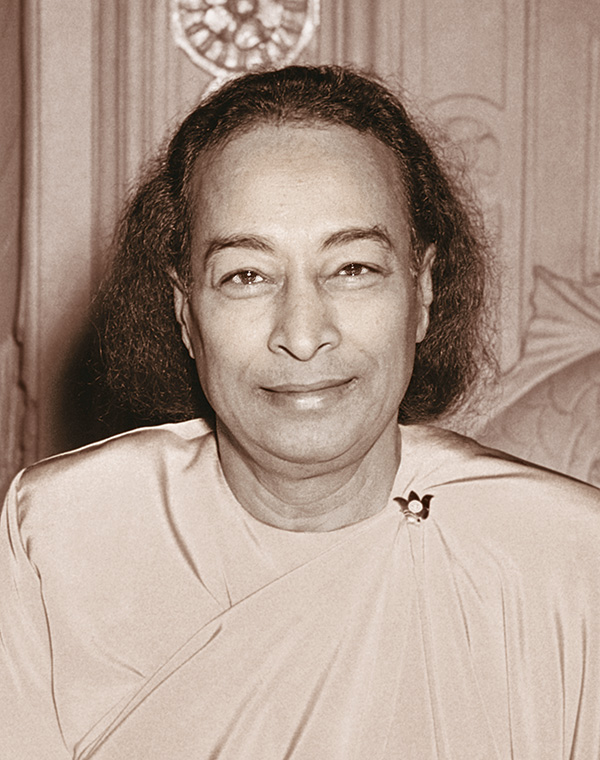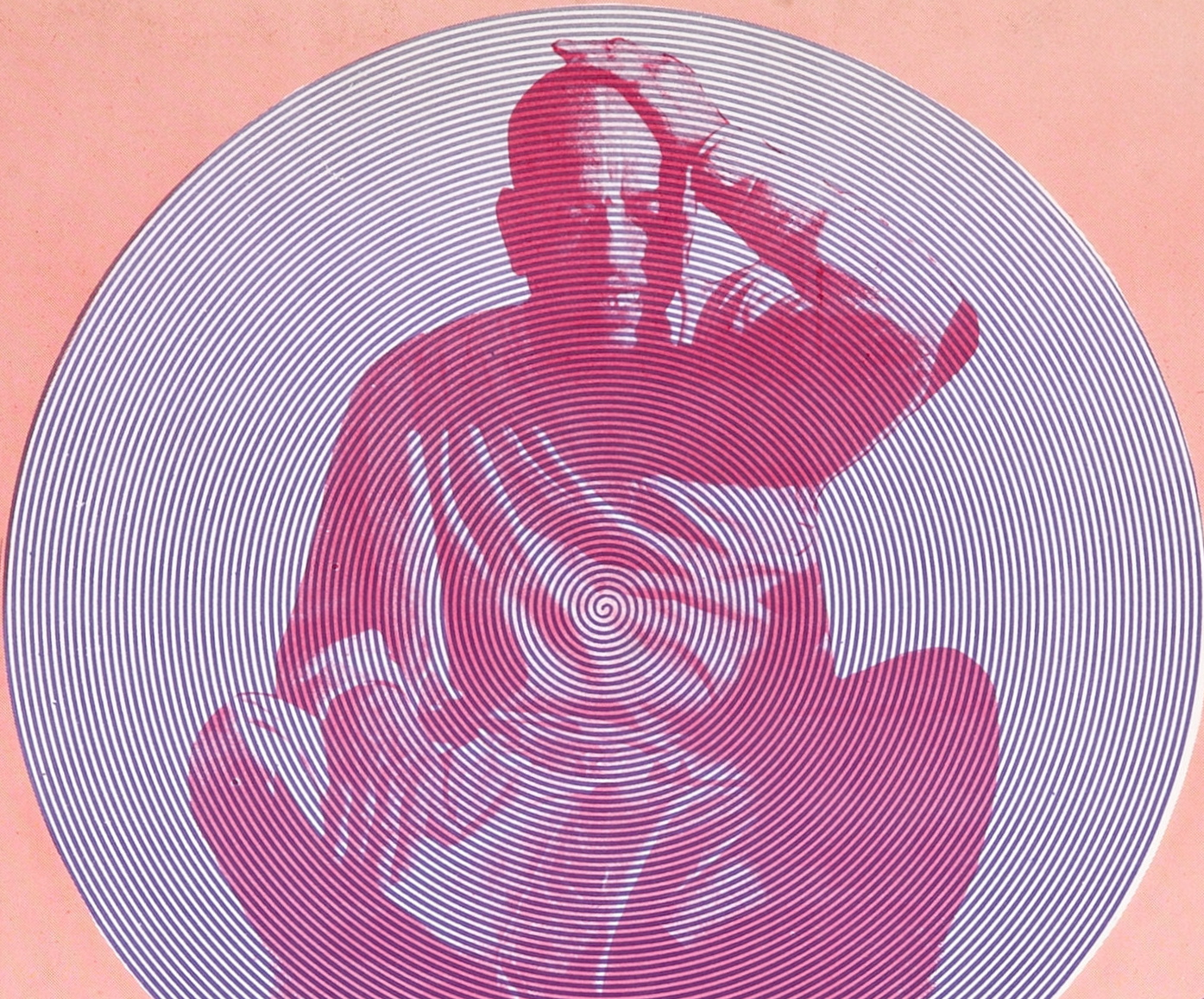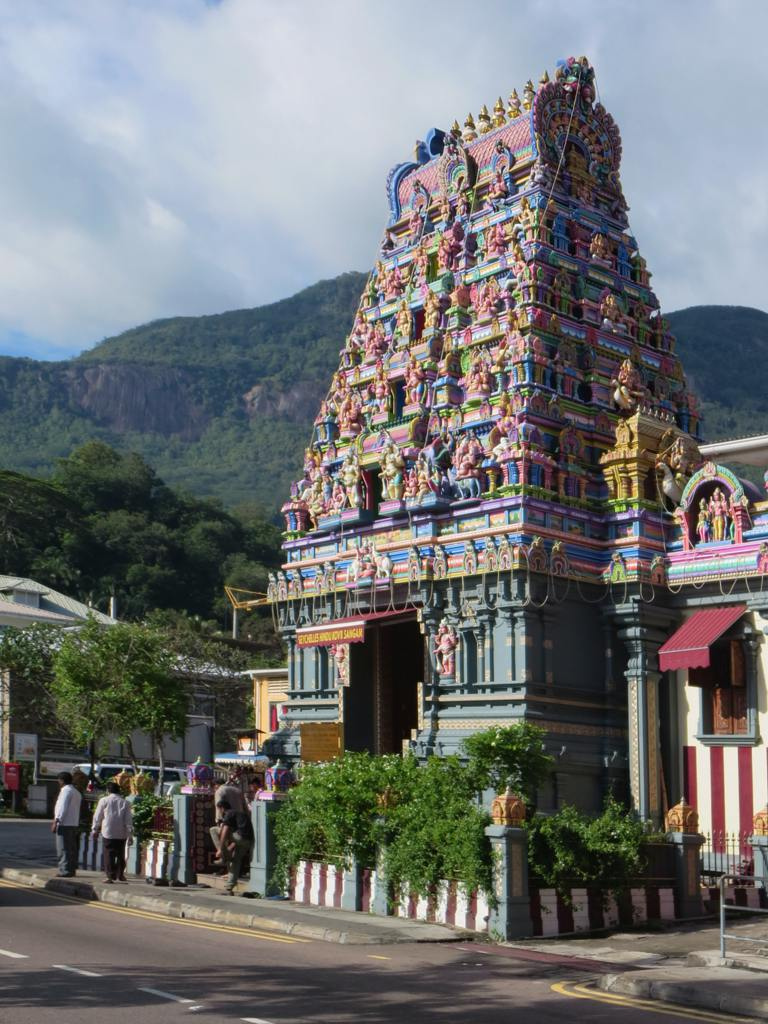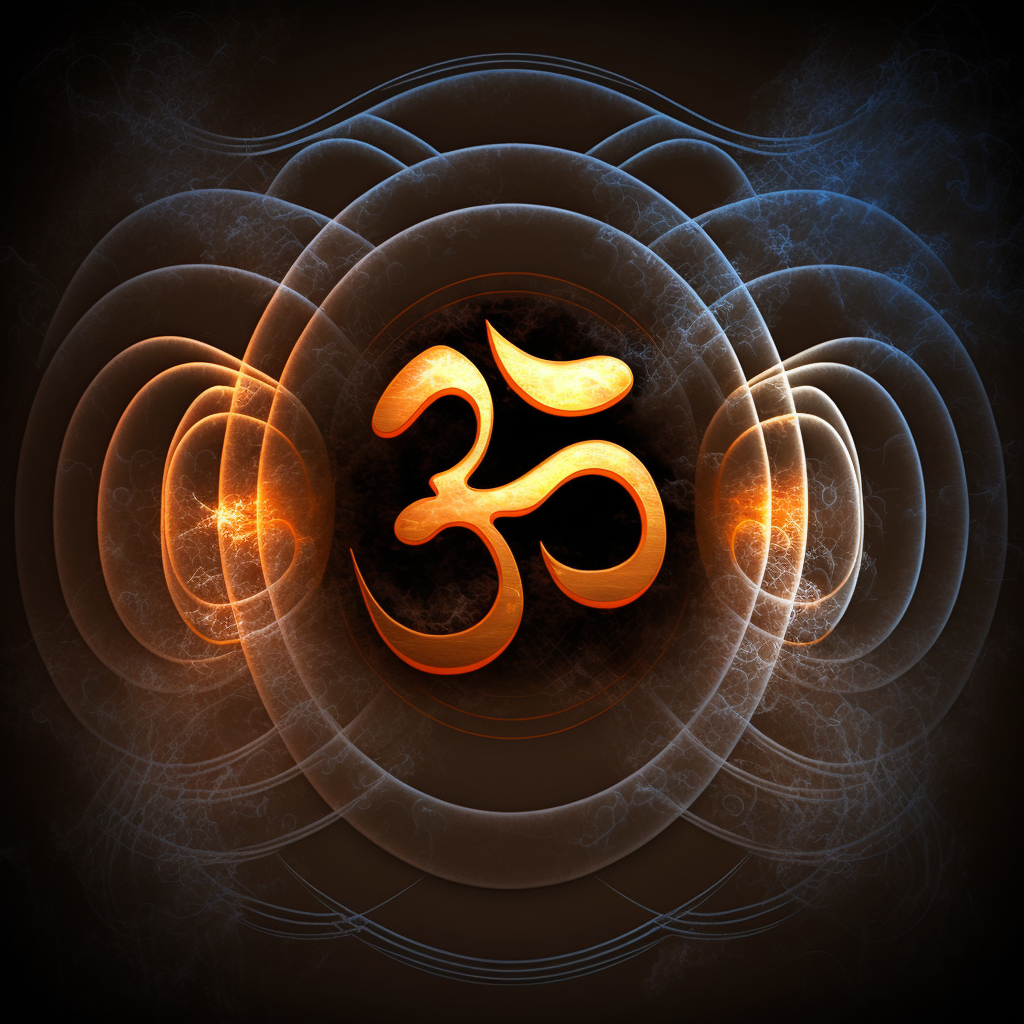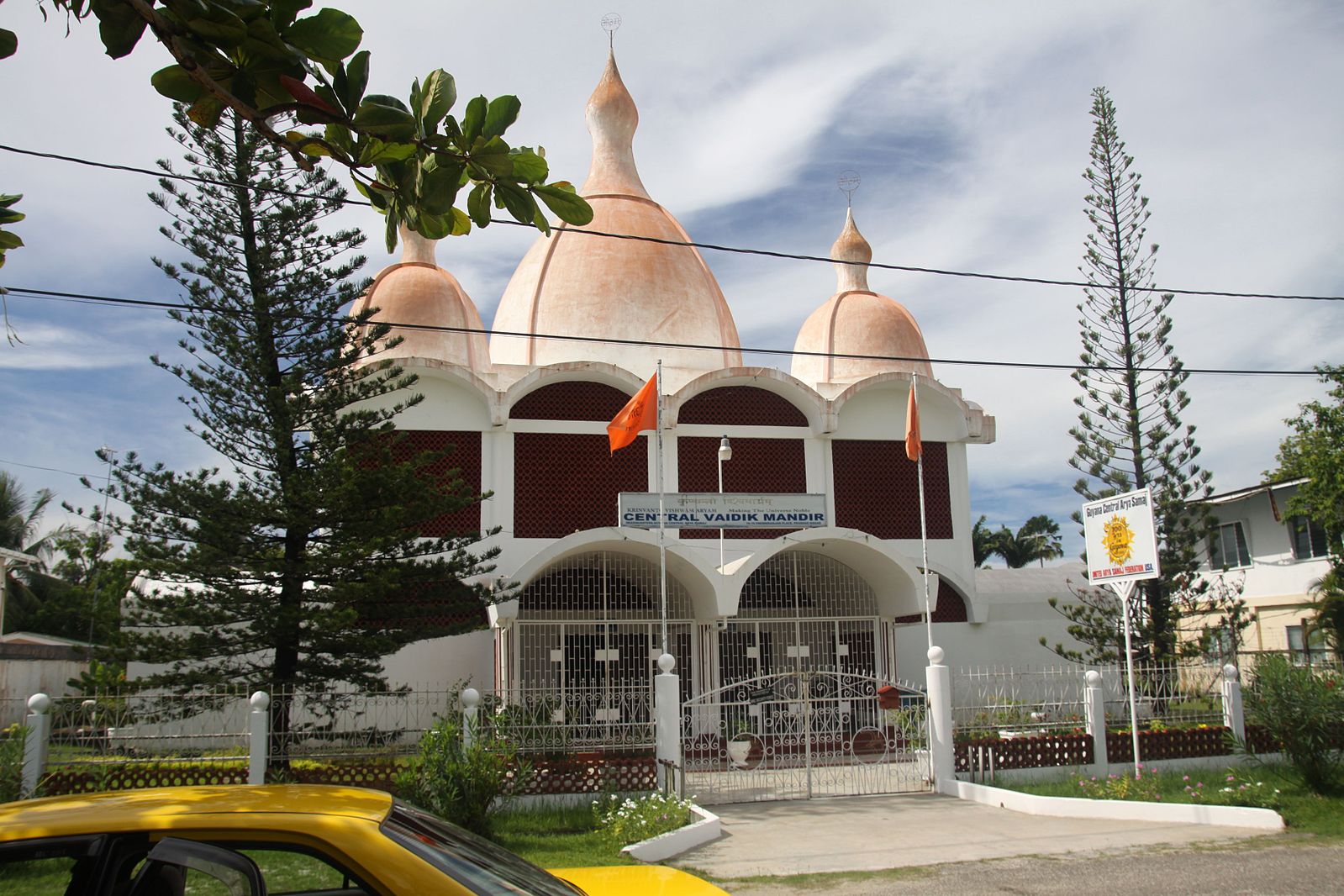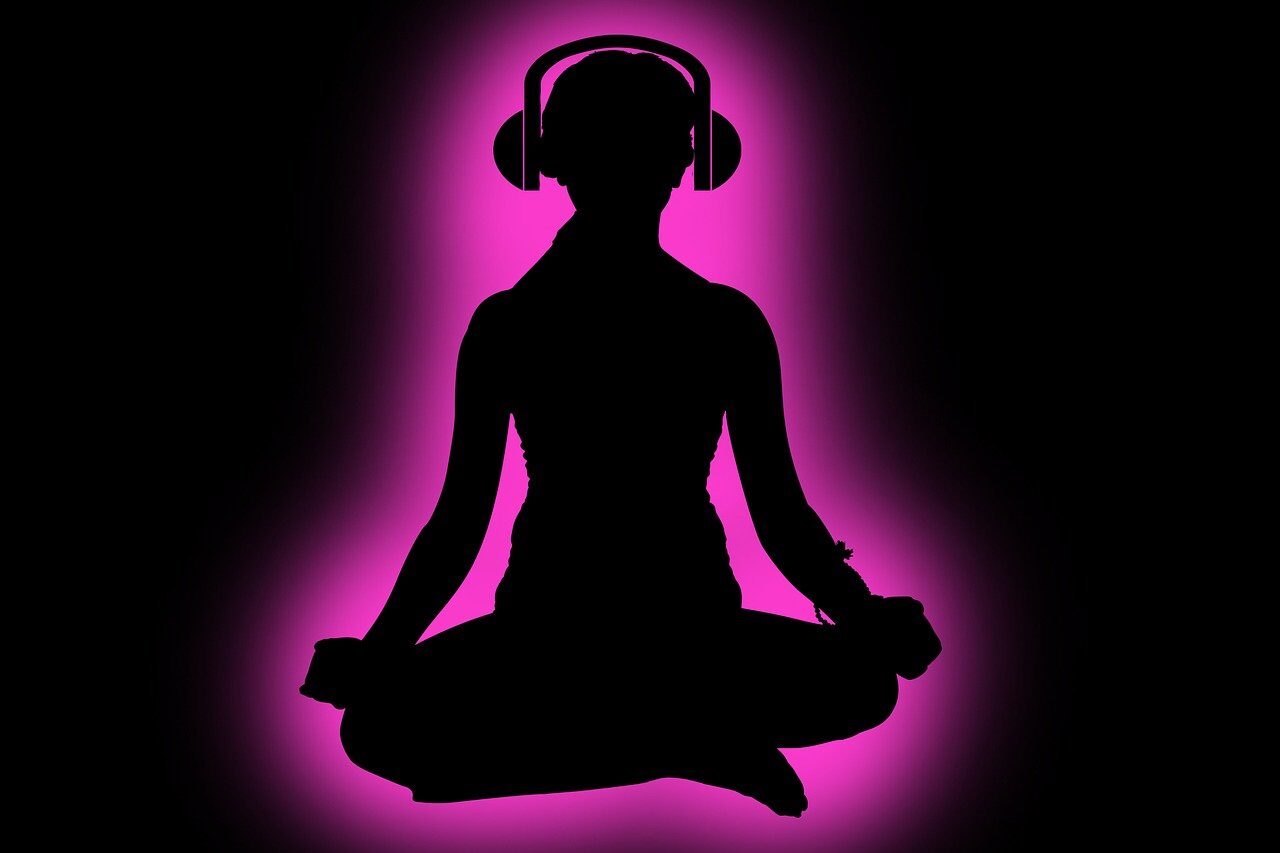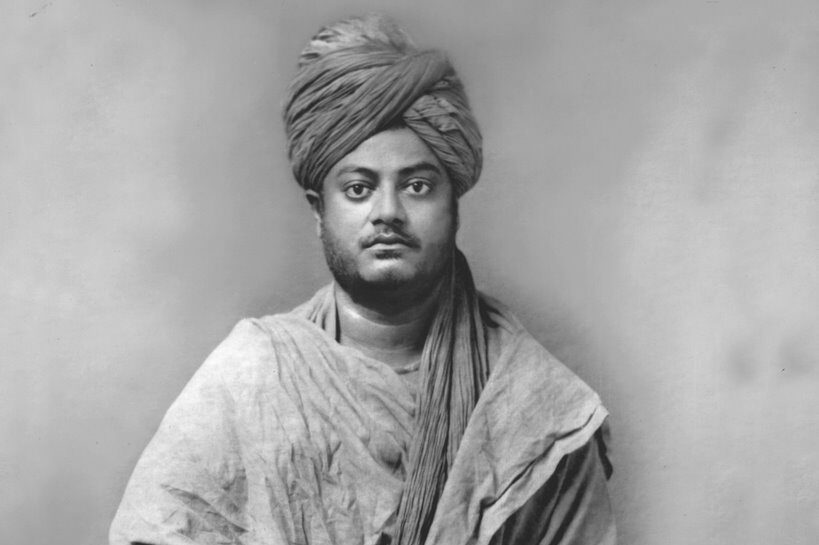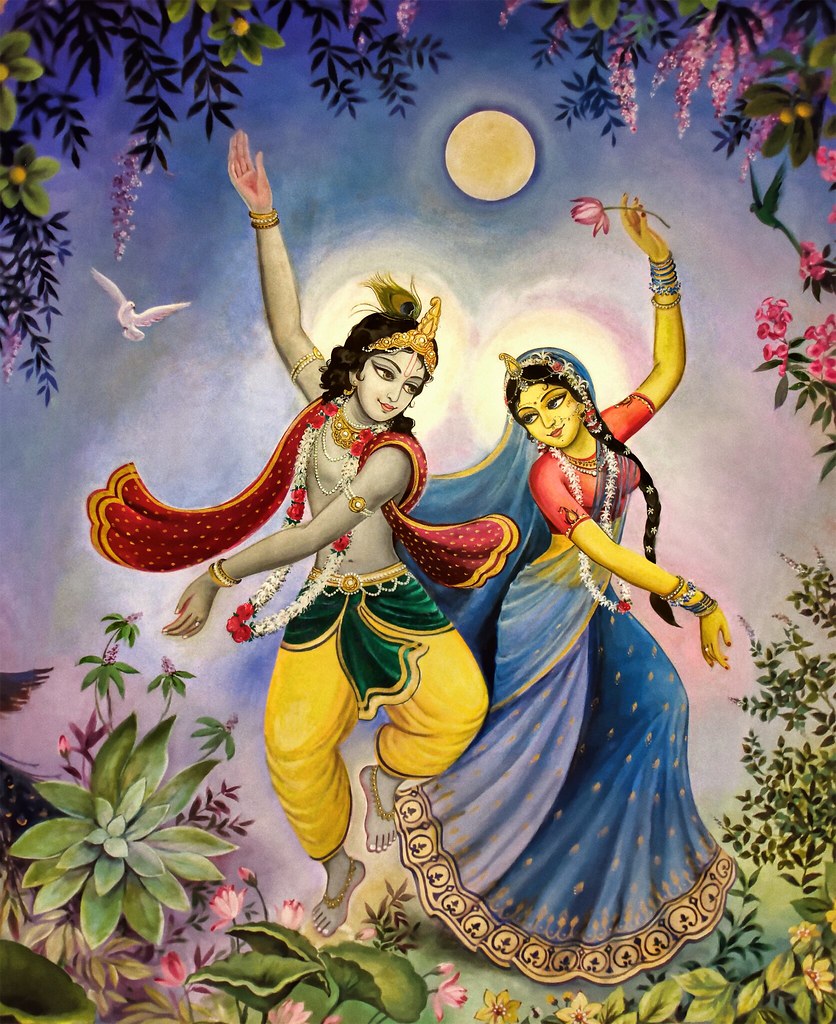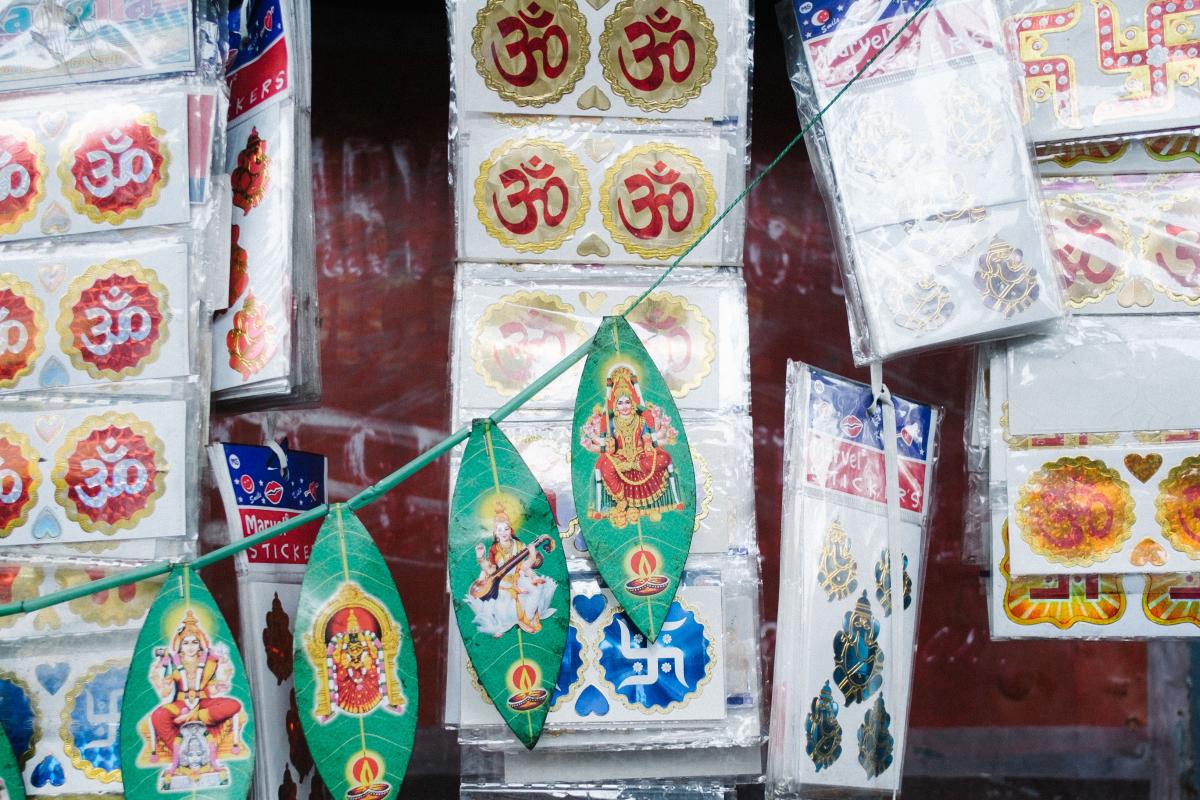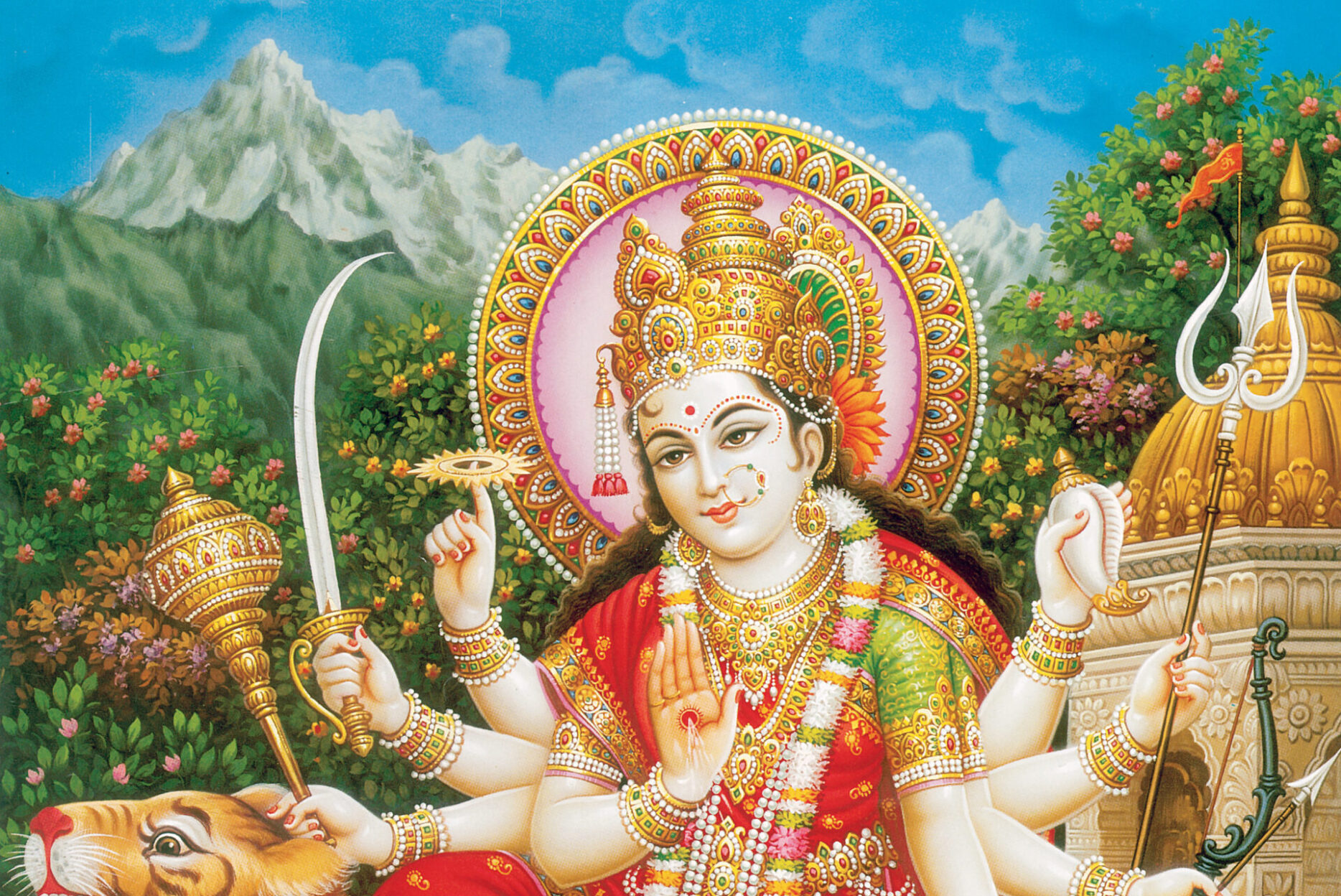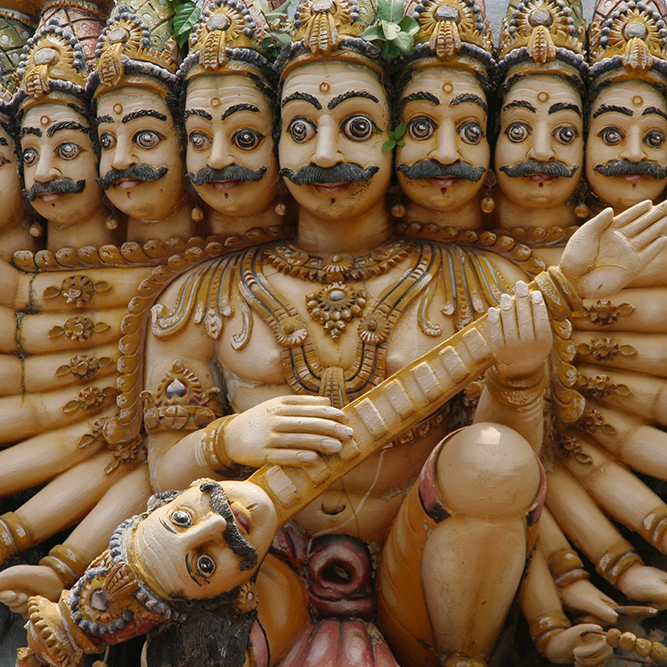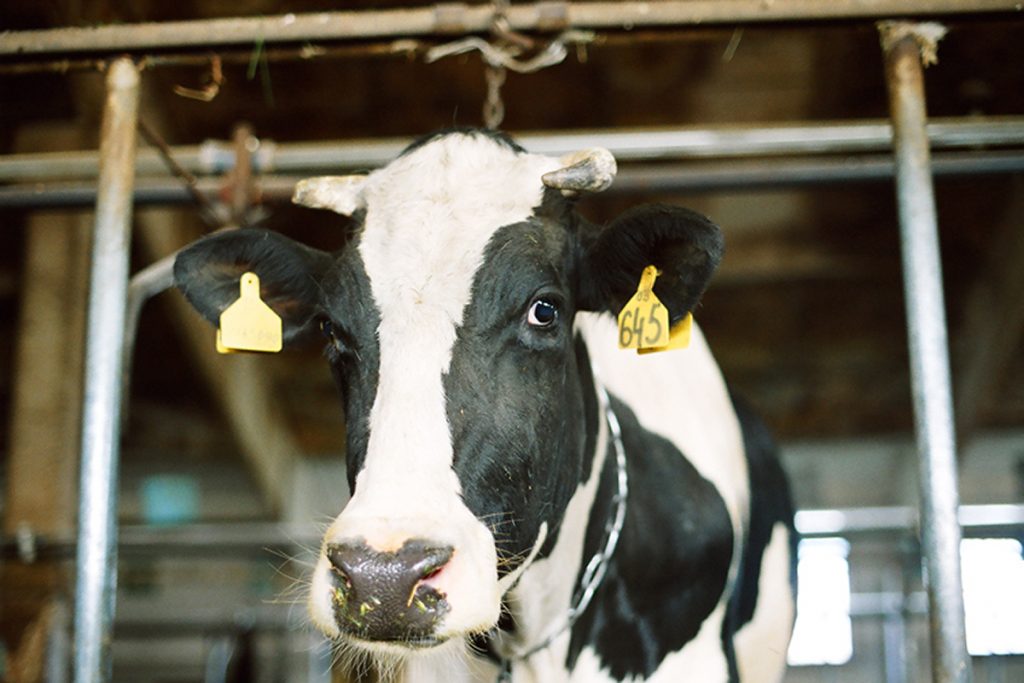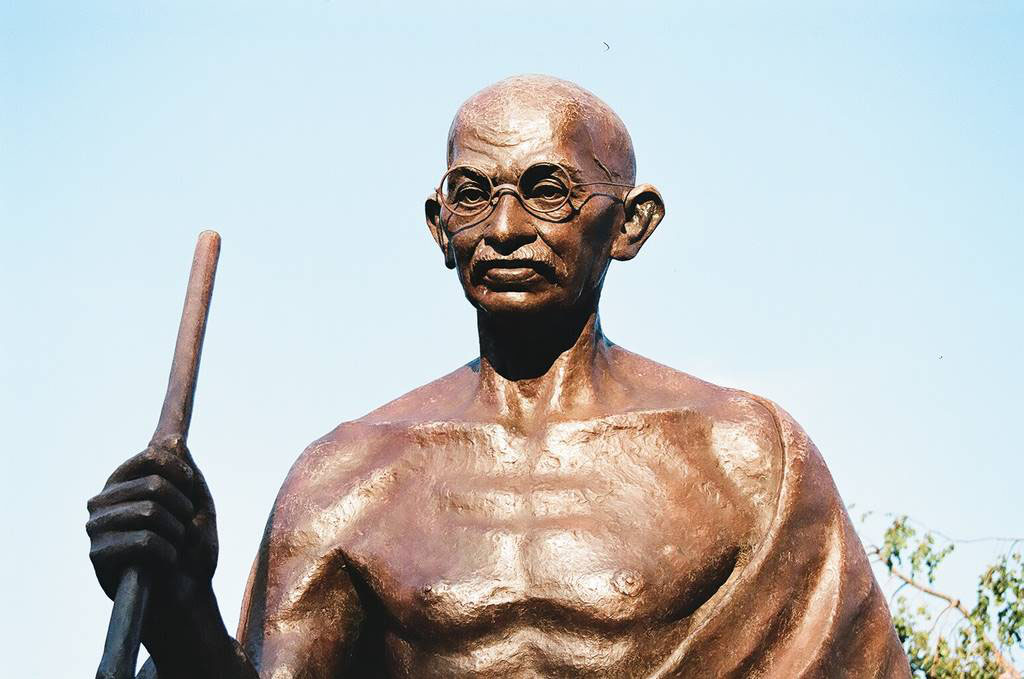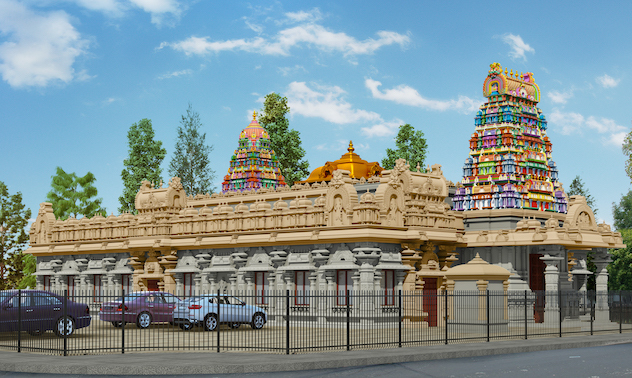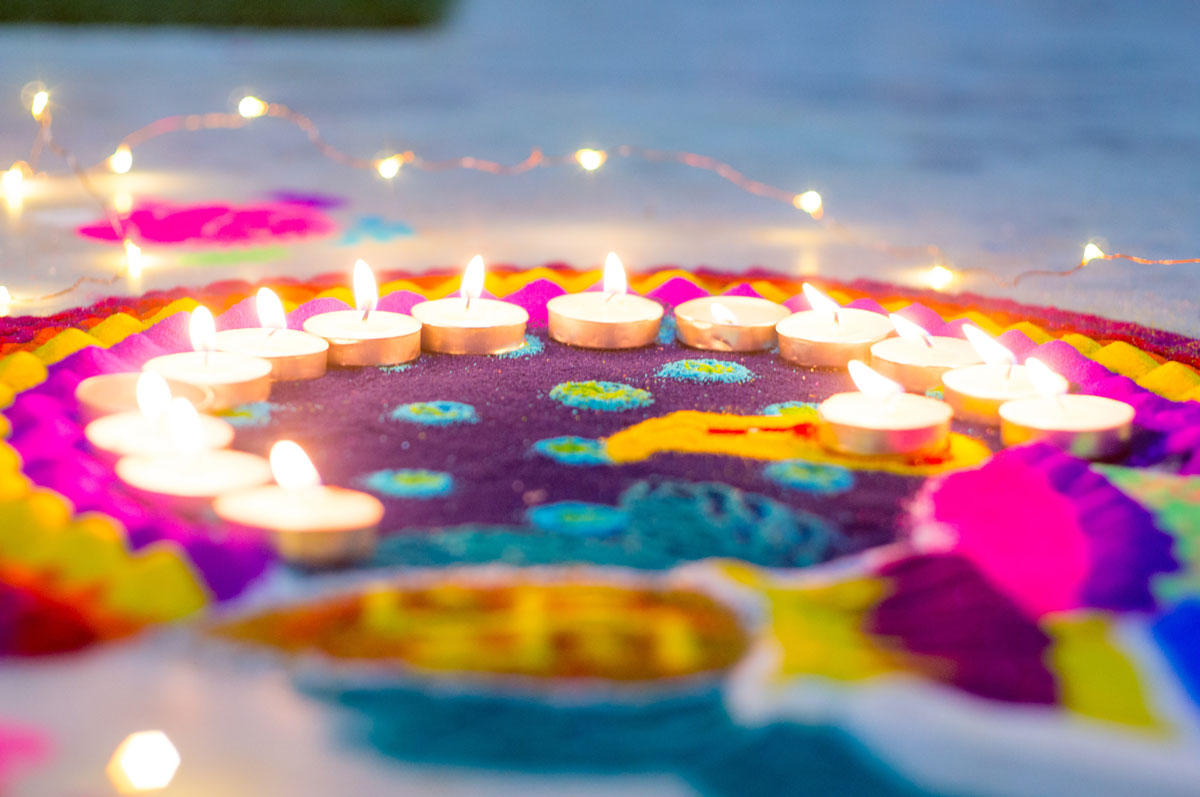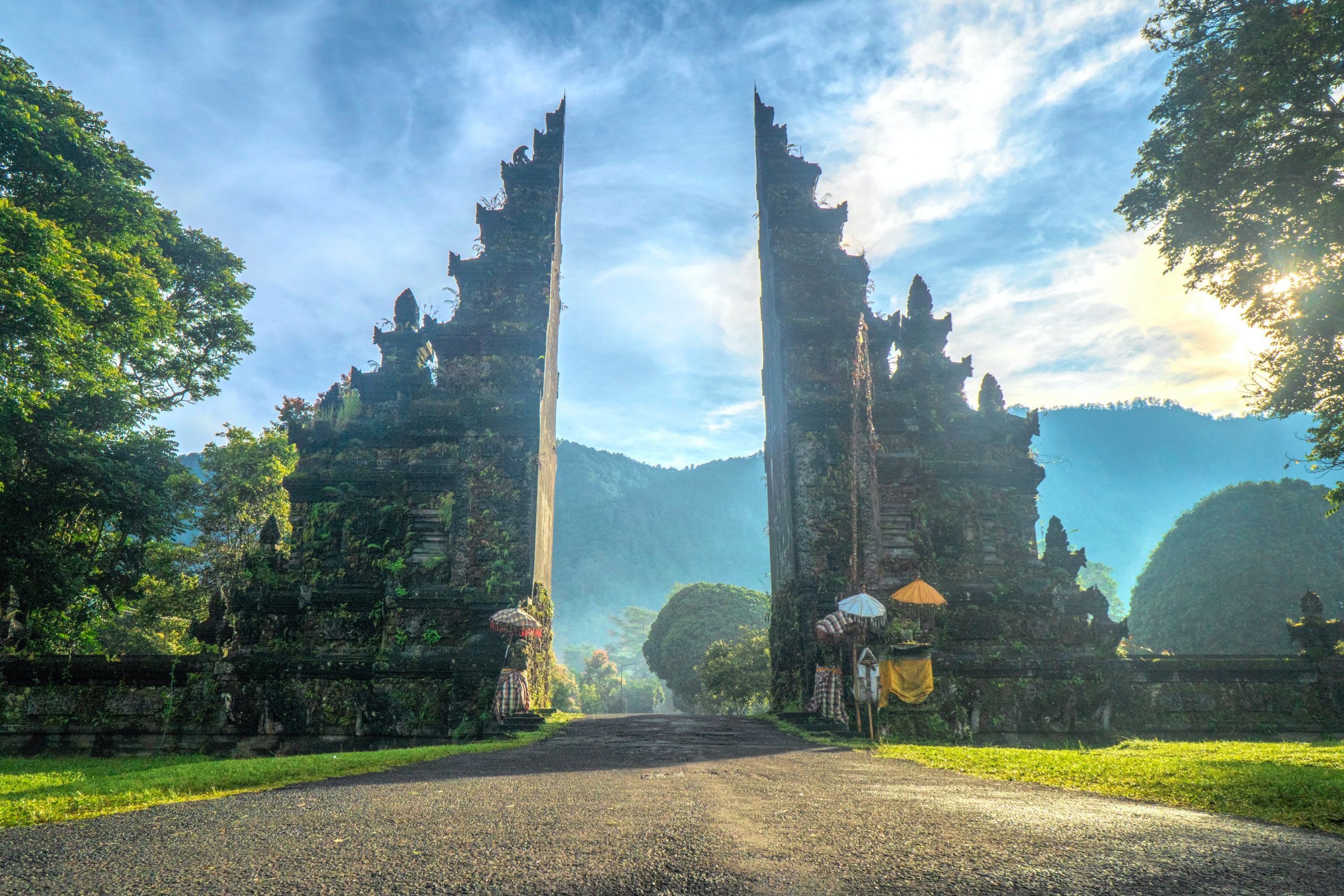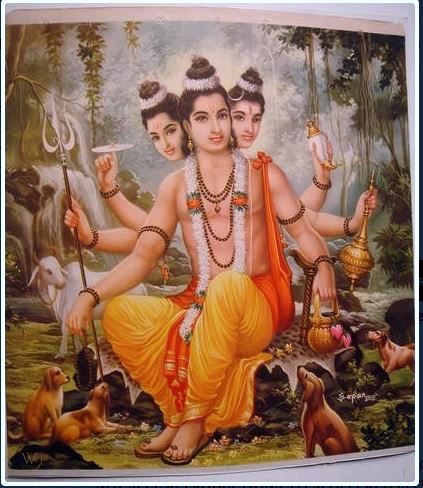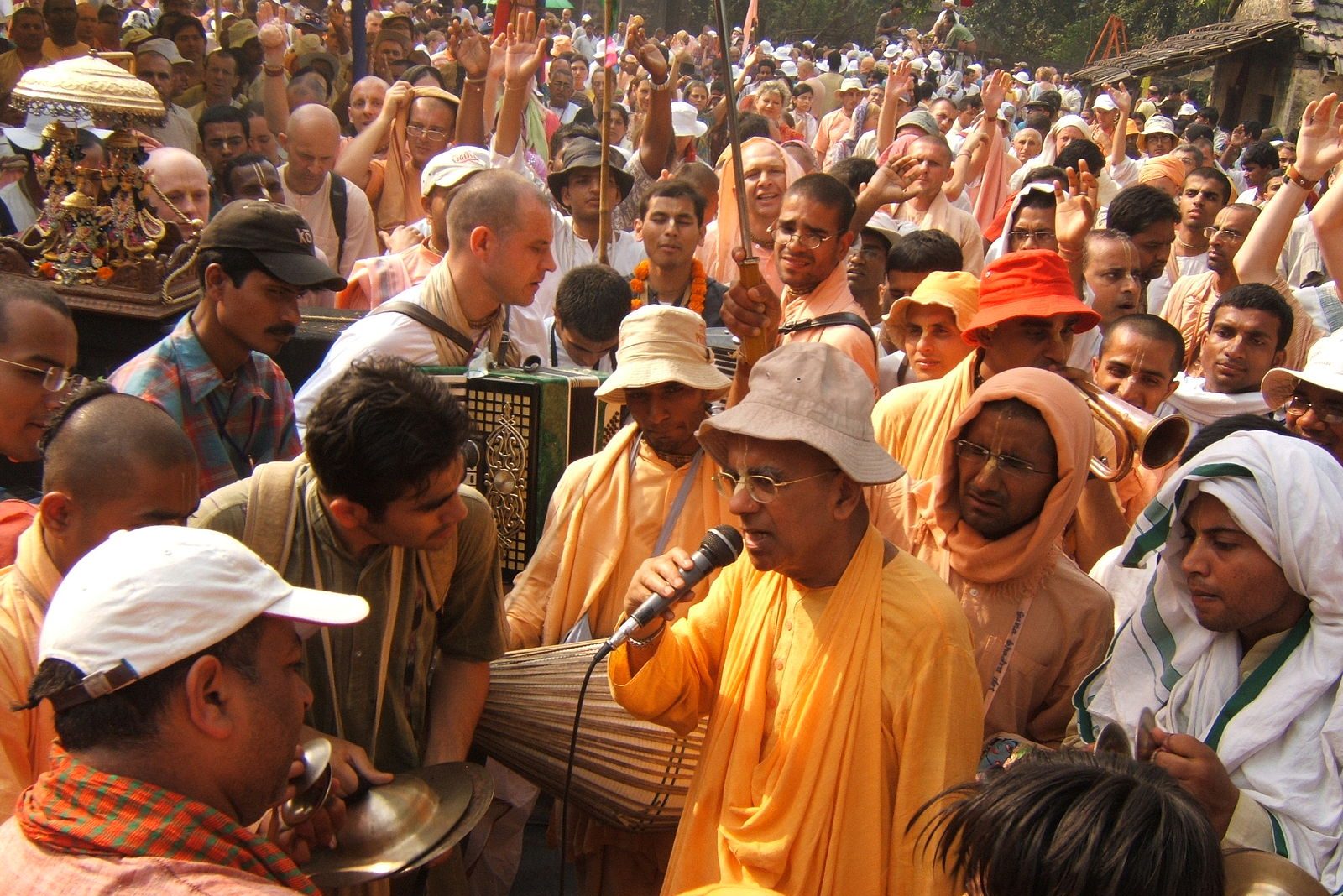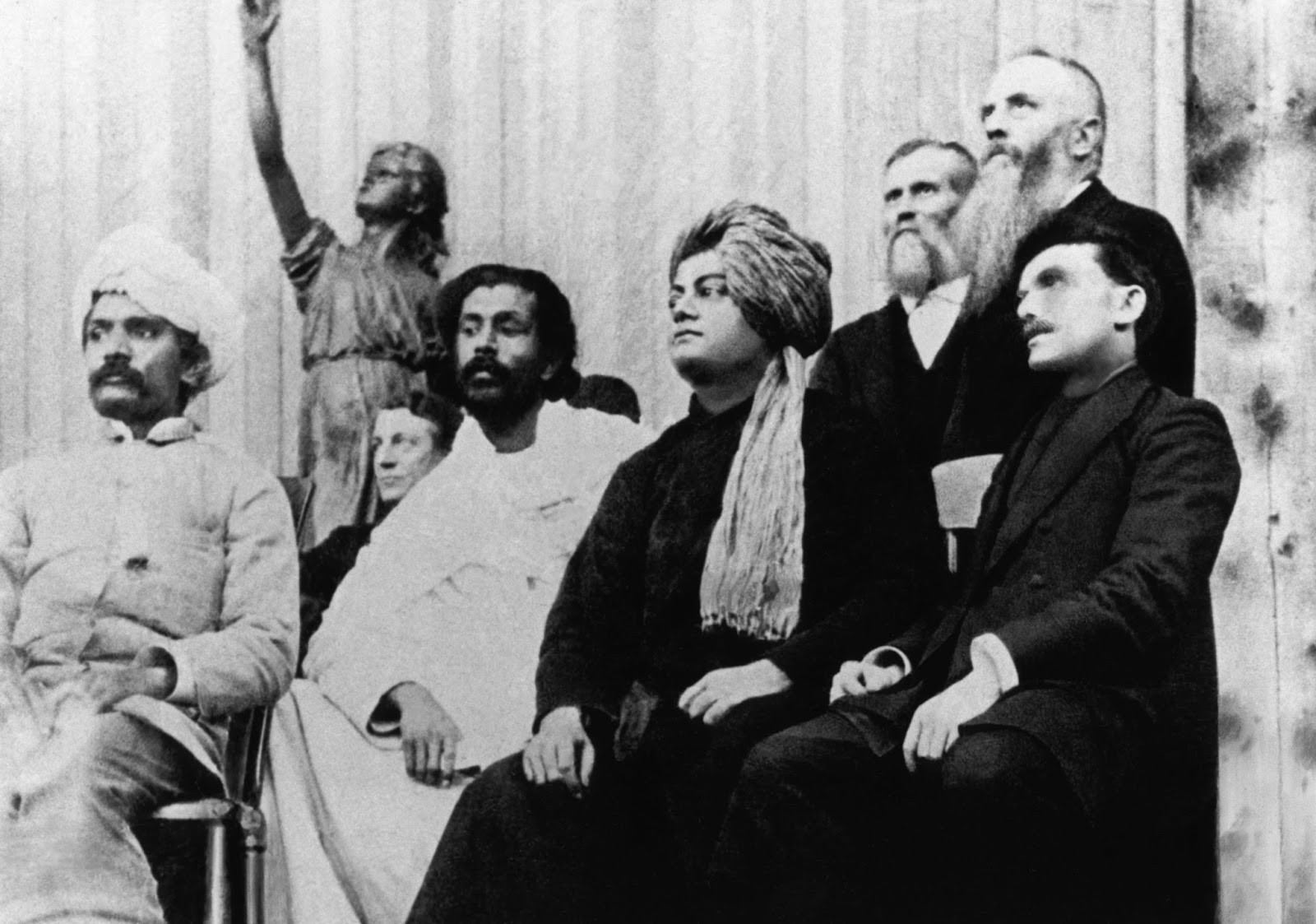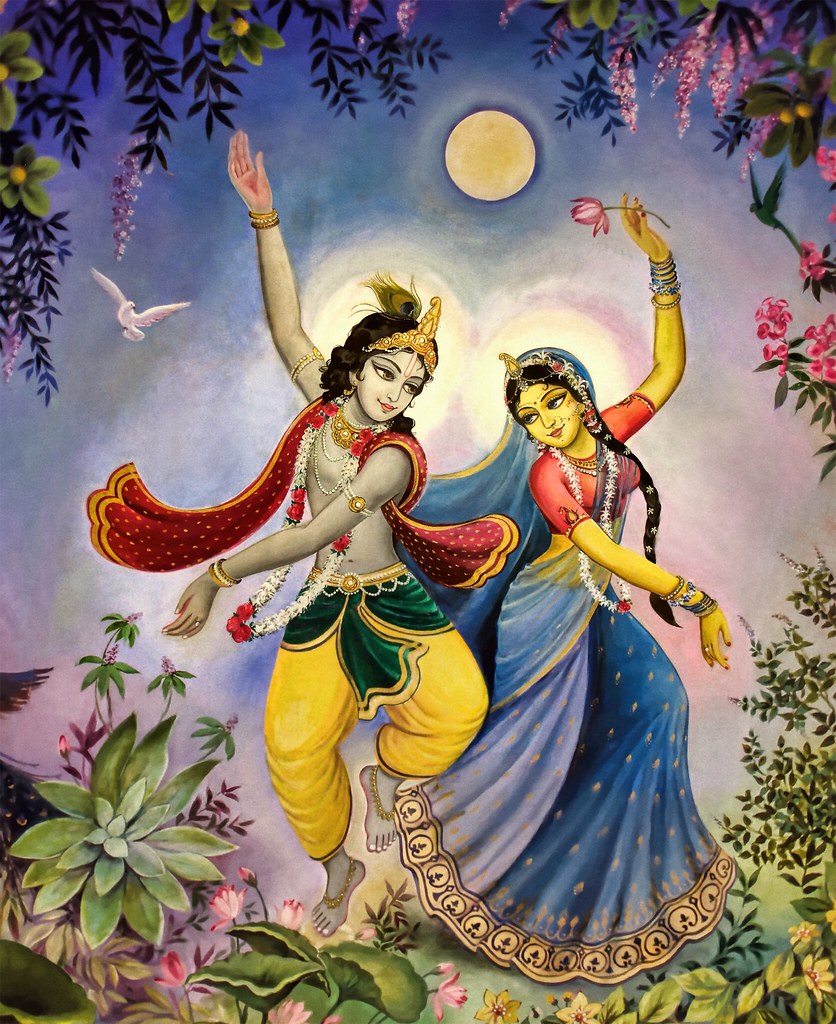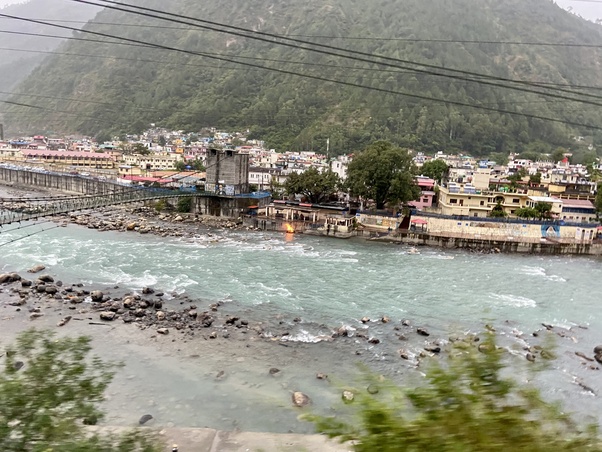
Finally we reached Uttarkashi town proper, nestled at the southern foot of Varanavata Mountain (of Mahabharata fame, site of the infamous House of Lac incident), enclosed by three sacred rivers: the Bhagirathi Ganga to the south, the Assi Ganga to the east, and the Varuna (or Varana, according to some sources) Ganga to the west.
Here is Uttarkashi, between Varanavata Mountain and the Bhagirathi Ganga:

The wonderful Yog Niketan Ashram
In Uttarkashi we joined some of my local friends who live there. We stayed at Yog Niketan Ashram right on the Ganga, by Kedar Ghat. My friends gave us a warm welcome, with a whole table spread with snacks and coconut wafers. My room had a balcony right over the Ganga, so I could just absorb the sacred bliss and blessings of Her presence without even moving. I sat and meditated on the balcony, just savoring the ancient depth of the spot.
Even in the room with the door closed I could loudly hear the soothing, glorious rush of the Ganga. I slept very well listening to that roar.
Yog Niketan Ashram is at the very southernmost point of Uttarkashi town proper, up against the Bhagirathi Ganga river which, since 1806, has formed the southern border of the town. Prior to 1806 the course of the Ganga was different. The Bhagirathi Ganga flowed on both the north and south sides of Uttarkashi town. In 1806 an extremely powerful earthquake struck the region. A huge piece of Varanavata Mountain collapsed in a landslide, completely blocking the northern channel of the Bhagirathi Ganga and changing the river’s course. Now the Bhagirathi Ganga flows on the far south of town. Recognizing the auspicious northward curve of the new river as mirroring its motion in Kashi (Varanasi), the townspeople built Kedar Ghat and Manikarnika Ghat along the riverside. Indeed this was the first instruction of the town’s new Gramadevata at the time, Kandar Devata. Yog Niketan Ashram is right next to Kedar Ghat, within view of it.
The hidden treasures of Uttarkashi’s ghats
Uttarkashi is sacred to Shiva. He is clearly the main Deity there. Locals associate Uttarkashi with the third spike of Shiva’s trident, the other two being Kashi and Guptakashi. Uttarkashi is laid out in replica of Kashi, right down to the daily crematory pyres on the river Ghats. Even the river follows suit, making the same auspicious northward turn as it passes under the footbridge near Manikarnika Ghat, within sight of my balcony. The Uttarkashi Mahatmya or Varanavata Mahatmya in book seventeen of Skanda Purana claims that Uttarkashi replaces Kashi as Shiva’s main home during Kaliyuga. Raja Jada Bharat famously renounced his throne to seek the Divine in Uttarkashi.
Most pilgrims who pass through Uttarkashi only visit the Vishwanath Temple in the center of town. This is indeed the soul of the town, after of course the Ganga Herself. However, the traditional start to Uttarkashi Yatra begins at a different temple — not with Ganesha, unusually, but with Bhairav, at the Ananda Bhairav Temple on Bhairav Chowk, two hundred meters directly east in front of the Vishwanath Temple. Ananda Bhairav, the sattvic form of Bhairav, is the town administrator, and His blessings are said to open the doors for successful Darshan of Shiva, so the Shastras prescribe first honoring Bhairav and taking His permission before exploring the city.
Uttarkashi’s ghats are hidden treasures. Tourists rarely find their way to this back side of town, but personally I find this riverfront to be the town’s most charming area. This is sadhu territory, where the ancient atmosphere of renunciation prevails. It is an ideal place for silent meditation.
Kedar Ghat, also called Mukti Ghat, is the most auspicious ghat in town, but also where the near-daily cremations are held, being on the south edge of town by the river. Unlike in much of Bharat, here the cremation ground is not very secluded, but is considered a sacred presence aiding the spirit of unattachment and vairagyam. Indeed the cremation flames are in fairly open view, and the smoke bathes ashrams. At one point I told a fellow traveler: “Just FYI, your wet clothes on the balcony are getting snowed on with human ashes.” A young woman comes each day to sweep the ashes away. The bathing ghat is only about twenty feet upstream from the burning ghat. Once while bathing there together with local men, I found myself literally bathing in a rain of human ashes; it feels somehow freeing. Mahadev’s unique atmosphere of impermanence is strong. Uttarkashi feels like home to me, ashes and all. Here is the somewhat foreboding crematory site when not in use:
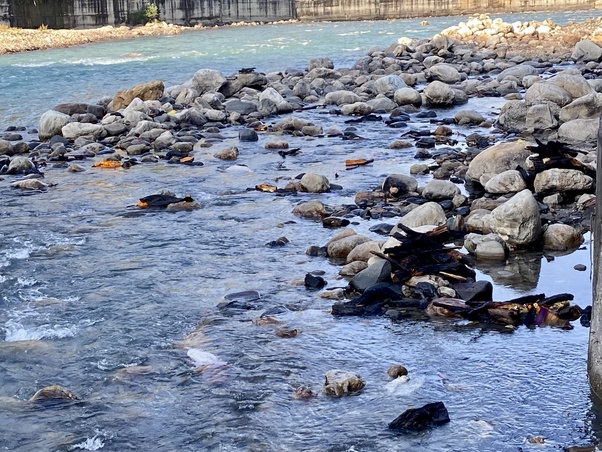
Right on what is now Kedar Ghat stands a very ancient Shiva Linga. It is said to have manifested together with the Panch Kedar Lingas during the Pandavas’ time. It is a smaller version of the Kedarnath Linga and is said to convey the same transcendental energy. The temple built around it is likewise called Kedarnath Temple, and it is the namesake of Kedar Ghat.
Its door is literally just a few paces from the front gate of Yog Niketan Ashram. This place, where Kedar Ghat now exists, is said to have been one of Shiva and Parvati’s favorite playgrounds. Like the main Kedarnath Temple, this Kedarnath Temple also faces south. After the destruction of the 1806 earthquake this Kedarnath Temple fell into dereliction, and was adopted by the Ramanandi Vaishnava order of monks. They keep the temple neat and clean, and the Kedarnath Linga’s aura of silence penetrates throughout the area. The Ramanandis have added a Ram Mandir within the main temple, and now Shiva and Rama are venerated there side by side. The monks feed the street cows daily, which has led to very plentiful and charming bovine attendance outside the temple.
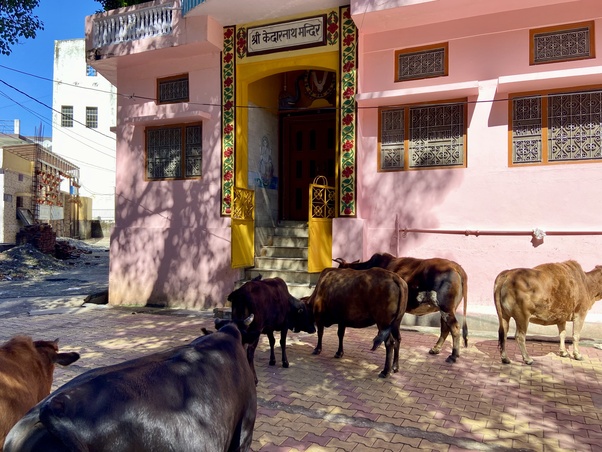
It is a very silent temple (except during morning and evening Aarti), an ideal place for meditation.
In the courtyard between Yog Niketan Ashram on the east, Kedarnath Temple on the north, and Kedar Ghat on the south (all in an area the size of a single, fairly small city block), there stands a massive, ancient Pipal tree — another ideal meditation site.
The tree is often full of sweetly chirping birds. In fact, for thousands of years meditation caves lay deep underground directly beneath where the Pipal tree now grows. Sadly floods from the 1806 earthquake destroyed these ancient caves, but the power of millennia of meditation remains.
From Kedar Ghat and Kedarnath Mandir, several walkways wind along the river and between various ashrams (including Yog Niketan) and temples, in a secluded little sacred district south of the main town market, called Hanuman Chowk. Here is one of those alleyway temples:
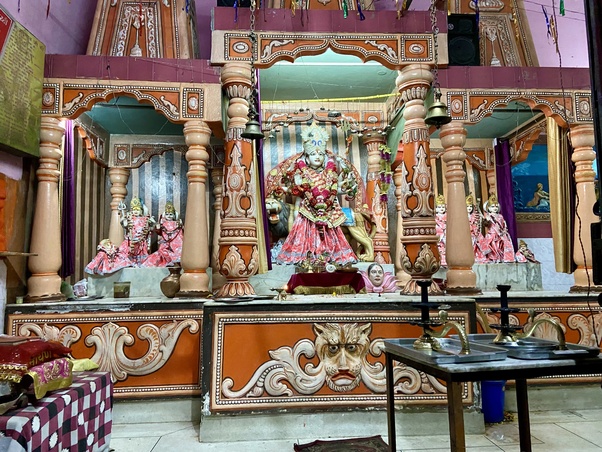
I explored about the area and its surroundings. Walking west (downstream) along the river from Kedar Ghat, past the crematory ground, is Manikarnika Ghat. There is a Ganga Temple, rebuilt since 1994, when an earthquake partly destroyed the old stone and slate-roofed one.
Further downstream that way is the ancient Kali Maa temple, once the site of animal sacrifices to Kali, before Ananda Bhairav forbade them — perhaps reflecting a historical dispute or power struggle between Shaiva and Shakta priests in the area, which the Shaivas dominantly won throughout the Kedarkhand region, outlawing all blood sacrifice.
Heading north into the thick of town, into Hanuman Chowk, one finds the Parade Grounds where town fairs are held. Most of the year it is a silent oasis, an open field in the middle of town. In that open field area stands the 150-year-old Ekadash Rudra and Ambika Temple compound.
The hundred temples of Uttarkashi
There are probably a hundred temples in Uttarkashi, they’re everywhere if you just walk around the streets.
Lots of street dogs seem to hang out on Bhairav Chowk, most of them looking healthy and well-fed. They are very friendly; we were petting them a lot.
Near the Bhairav Temple on Bhairav Chowk, the temples of Kandar Devata, Parashuram, Dattatreya, and Annapurna all stand in a row facing west toward the main Vishwanath Temple.
Annapurna Temple is diagonally across from Bhairav. She is the Goddess of Food, the main sacred Goddess of Kashi.
Next to Annapurna is the small, ancient stone Dattatreya Temple. Dattatreya is the Adi Guru of the Nagababa Sadhus, who once inhabited this temple. They have since discontinued the use of this temple, as its Murti got worn out and deconsecrated. But it was considered such a historical piece that it was moved to the national museum in New Delhi. This temple is now a historical structure rather than an actively functioning place of veneration.
Next to the Dattatreya Temple is the recently renovated Parashuram Temple. Parashuram performed penances in Uttarkashi to purify himself of a sin. It is said that he became one of Dattatreya’s leading disciples here, and he taught the art of dhanurveda (martial arts) to Bhishma and Karna in Uttarkashi.
Near Parashuram Temple is Kandar Devata Temple. He is the presiding gramadevata (town deity) of Uttarkashi and one of the sixty-four Bhairavs. He is a relative newcomer. He became Gramadevata of Uttarkashi in the year 1806, following the great earthquake. Prior to that he was one of the main Devas living in Dharali, near Gangotri. The murti of Kandar Devata was washed away from Dharali in the destruction, and it appeared here in Uttarkashi, having seemingly miraculously traveled over fifty kilometers. The people of Uttarkashi say that Kashi Vishwanath, the town’s main form of Lord Shiva, appointed Kandar Devata to preside over the region, and so they accepted him as their new gramadevata (replacing Ananda Bhairav in that technical role, I believe), and built the Kandar Devata Temple on the location where the murti appeared. Vishwanath is said to represent the silent, witnessing, sadhu aspect of Shiva, while Kandar is the administrative authority of Uttarkashi. Pandits carry the murti throughout the town to bless residents and advise them on matters of spiritual and worldly life. Devotees ask questions of the Deva. As one local put it to me simply: “Nothing is done without consulting Kandar Devata.” Even the human District Magistrate’s office is built right across from Kandar Devata’s temple, to have his appropriate influence present in all decisions.
Two blocks south of the main Vishwanath Temple, directly between Vishwanath and the Bhagirathi Ganga river, is Totaka Ashram, across from the District Library. The Totaka Ashram, a Smarta ashram in Adi Shankaracharya’s tradition, contains a Smarta Shiva temple, the Koteshwar Temple, one of the Sapta Vishwanath Temples of Uttarkashi. Right across the street there is a small Gopal Krishna Temple.
My friends and I went also to Ananda Bhairav Temple. My local Uttarkashi friends are themselves friends with the ancestral priest of Ananda Bhairav, Pandit Uniyal. Pandit Uniyal met us at his temple, invited us all the way into the garbhagriha, entry to which is usually forbidden except to priests, and we performed Ananda Bhairav Puja together under his guidance.
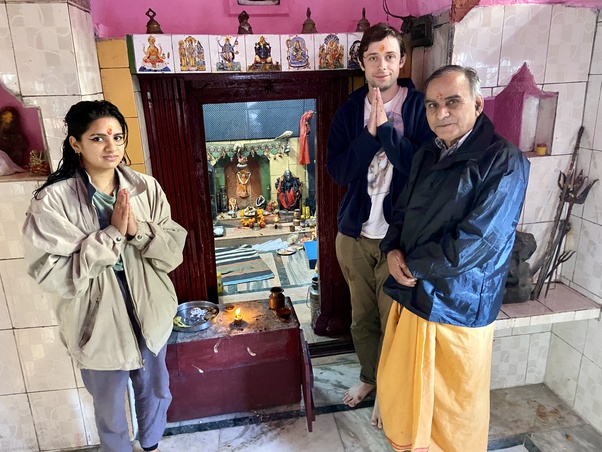
Kalabhairav, the tamasic form, was the one that severed the fifth head of Brahma. The head stuck to his hand, and he could not drop it. He wandered about, doing Tapasya in various places to free himself from the curse of murder. Uttarkashi was one of the two places of his most intense tapasya, along with Ujjain. Finally, in Kashi, the head, by then decayed to a bare skull, fell from Kalabhairav’s hand. Then, to complete his penance, Kalabhairav went to Brahma Kapila Kund at Badrinath to perform Shraddha for the fifth head of Brahma. After that, according to Pandit Uniyal, with Shiva’s blessings Kalabhairav assumed the Sattvik, blissful form of Ananda Bhairav and came to dwell in Uttarkashi.
Uttarkashi and Haridwar are both homes to Ananda Bhairav. In most Bhairav temples alcohol and meat are offered, but not to Ananda Bhairav; only sattvic offerings are allowed. In fact, Ananda Bhairav has forbidden sacrifices of living animals throughout Kedarkhand — the land of the Panch Kedar Temples, including most of the Himalaya mountains of Garhwal — unlike in neighboring Nepal, where Tantric animal sacrifices are still common. (Although, I happen to know that some Kalikula Shakta Tantrikas in Kedarkhand secretly, and illegally, do continue blood offerings.)
Then we went to the main Uttarkashi Vishwanath Temple. On the wall by the entrance is carved a Sanskrit inscription, quoting Skanda Purana book seventeen: “Uttar Kashi gives salvation to living beings. Blessed are those who are fortunate to live here during the dark age of Kali Yuga — in this place where all the Devas reside.”
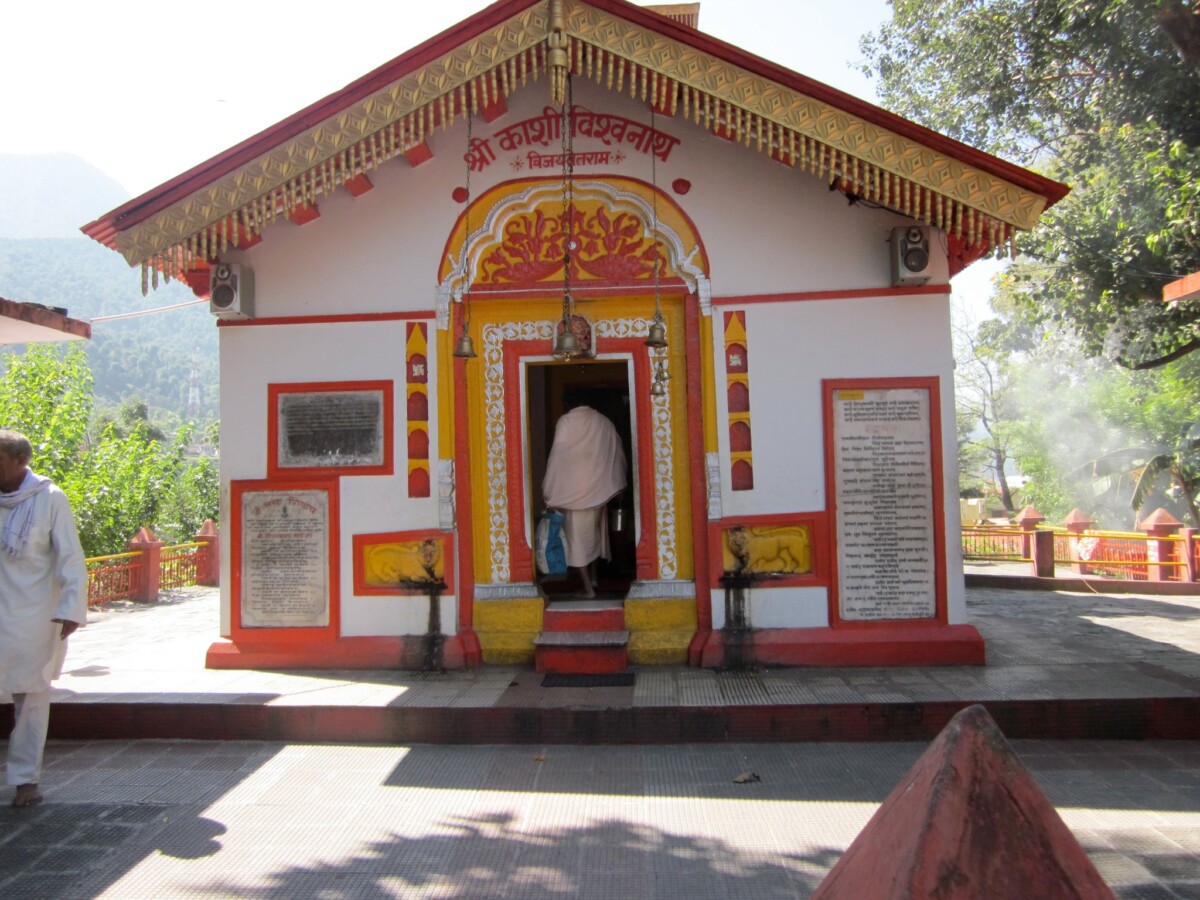
We went in and had a very long darshan of the ancient Shiva Linga, participating in Rudrabhishek. Kashi Vishwanath here represents the silent Sadhu aspect of Shiva, the witness of everything in the universe, but withdrawn, not acting in the world. Then we went and meditated together by the Homa Kund for some time.
The next traditional step of veneration is to visit the Shakti Trishul, within the Vishwanath Temple complex. The main form of Shakti in Uttarkashi has no humanoid murti at all, but is a 27-foot-tall trident made of ashtadhatu (an alloy of the eight sacred metals), embedded in the earth, sticking up like a flagpole, directly in front of the Vishwanath Temple. Shiva Purana describes how Shiva planted His trident here after defeating some asuras and sending them down to the Patalas; but the trident itself is said to embody Shakti rather than Shiva. The trident bears a Sanskrit inscription crediting the present Vishwanath Temple to Raja Ganeshwar, and the enclosure of the Shakti trident to his son Guha. This small room was so packed shoulder-to-shoulder and chest-to-back with adoring devotees that to circumambulate the trident just once took about twenty minutes.
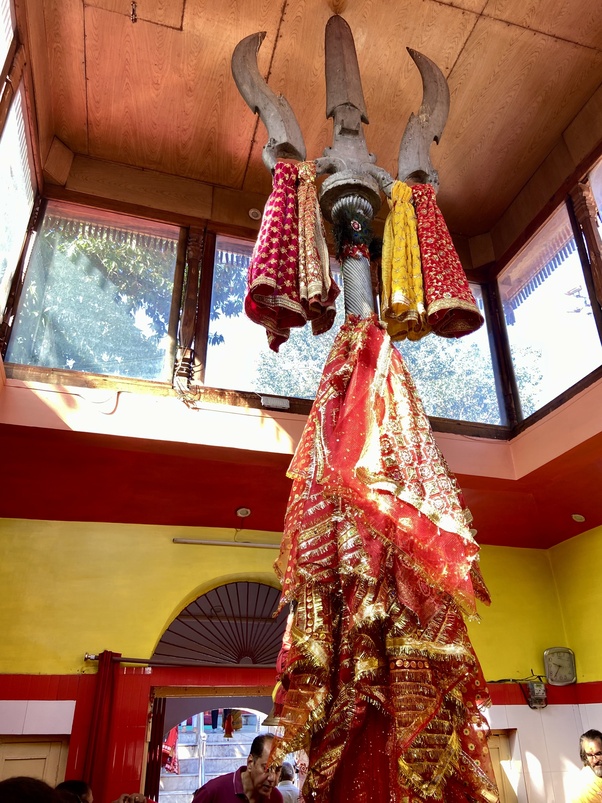
We also visited Kirateshwar Temple, dedicated to Shiva’s Kirata Avatar. Locals say it was here that Kirateshwar appeared to Arjuna. Kirateshwar is said to account for all who come to Uttarkashi for Darshan, and one’s pilgrimage here is not fully official, in a metaphysical sense, without a visit to this temple to have one’s attendance be formally recorded by Kirateshwar-ji. Kirateshwar Temple is one of the Sapta Vishwanath Temples of Uttarkashi.
This set of seven sacred temples is:
- Vishwanath Temple (the main one)
- Gopeshwar
- Kirateshwar
- Koteshwar (all these so far are within 100 meters of the main Vishwanath Temple; the rest are further away)
- Maha Kaleshwar, several kilometers west across the river.
- Laksheshwar, several kilometers east on the Gangotri Road. I have driven past that one several times but never had time to stop at it.
- Bimaleshwar, on the very peak of Varanavata Mountain which overlooks Uttarkashi from the north. Later in this very trip we did visit that one.
Next we went to Gopeshwar Temple, next on the list of the Sapta Vishwanath. Gopeshwar Temple is a charming, peaceful temple between the Vishwanath Temple and the Bhairav Temple.
It is so named because the Shiva Linga here was installed by Shri Krishna personally.
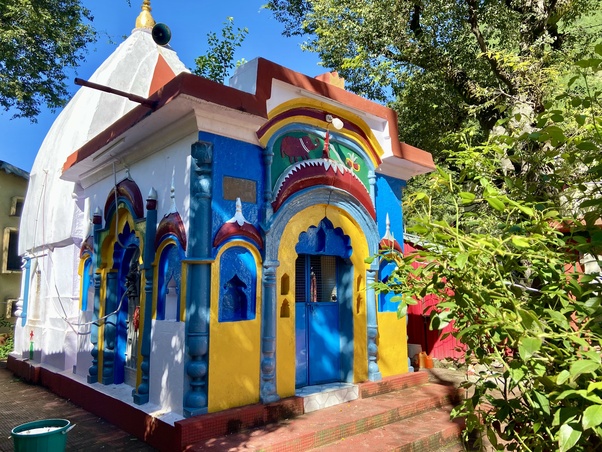
We also visited the Uttarkashi Anandamayi Ma Ashram, only about a hundred paces from the Yog Niketan Ashram where we were staying. Inside this Anandamayi Ma Ashram is a powerful Bengali-style Kali Temple established by Anandamayi Ma’s husband Bholanath-ji. There we found shelter from a sudden, brief yet torrential mountain rainstorm.
But I think my favorite spot in Uttarkashi is right by the Ganga, with the lovely street cows who gather and hang out there every day because the monks of the Kedarnath Temple feed them.
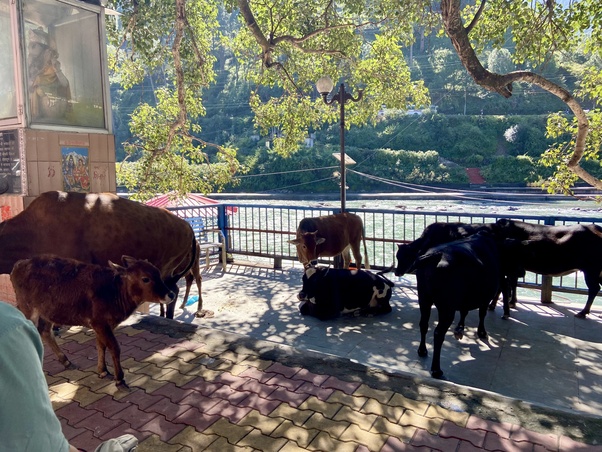
A note: Though I undertook this trip in the autumn of 2022, information on the temples and places visited presented at the links in this article are current as of mid-2025. Logistical details of getting between places can change quickly, however, and individuals should verify the latest information from other sources.
All photos in this article © Devala Rees.


